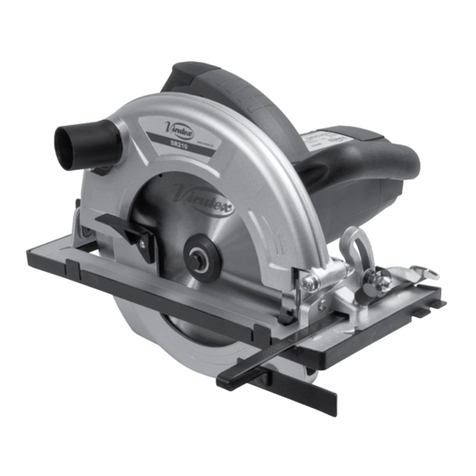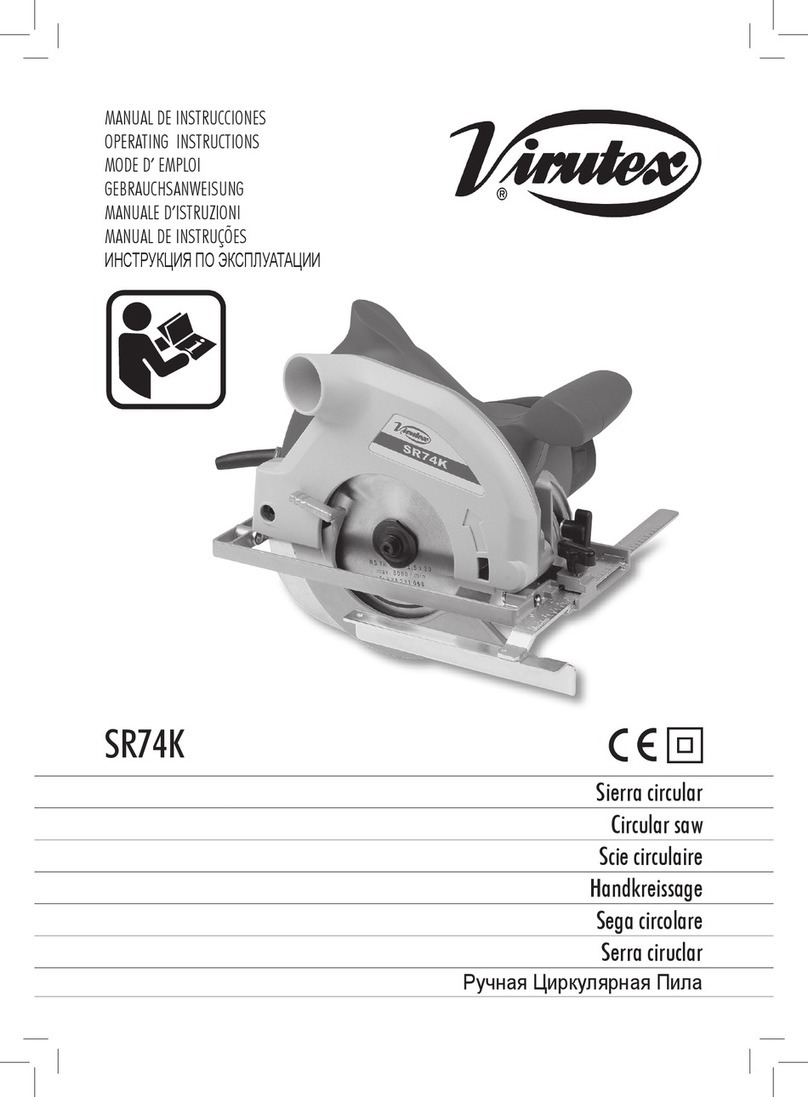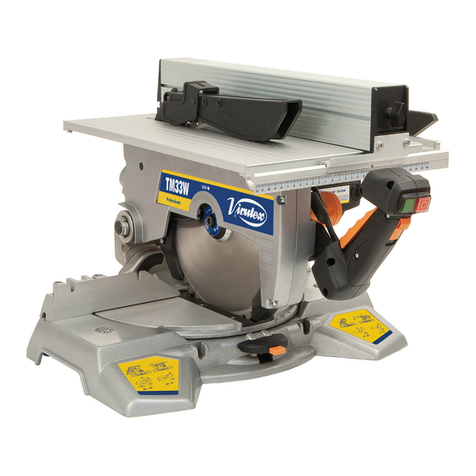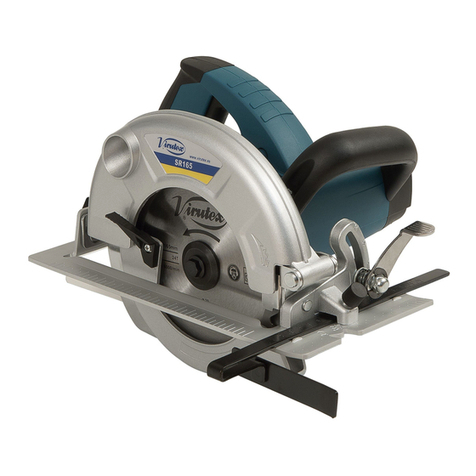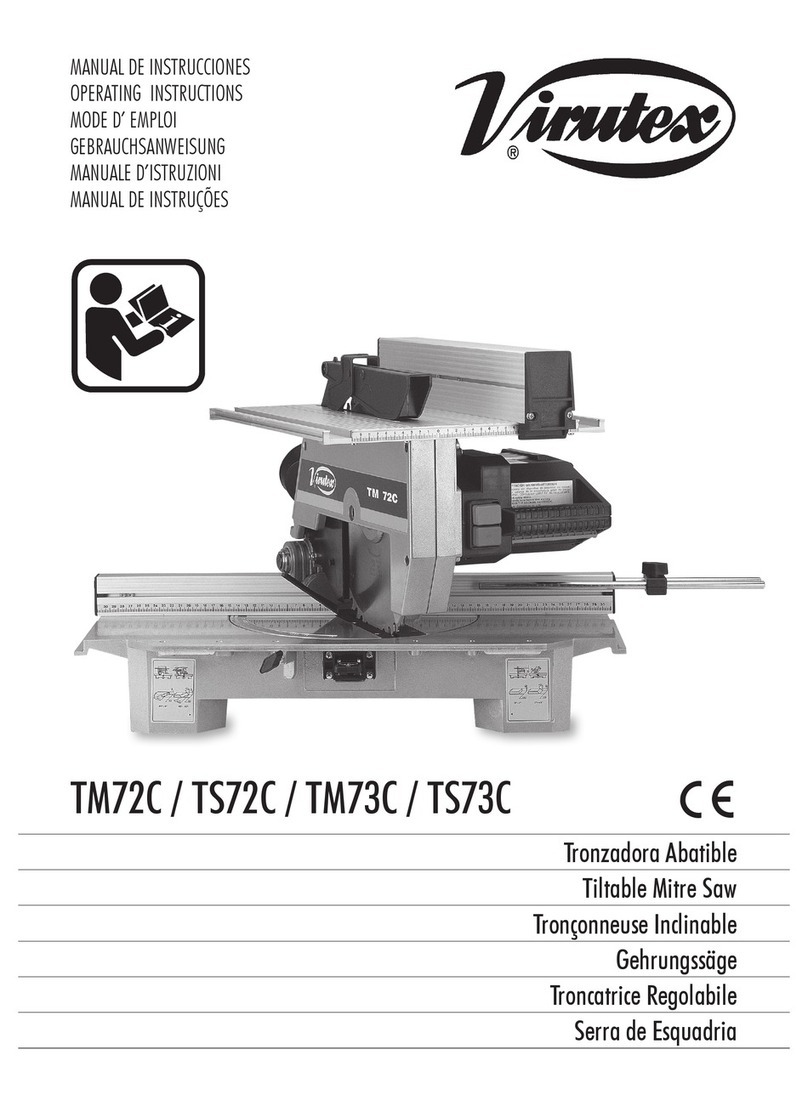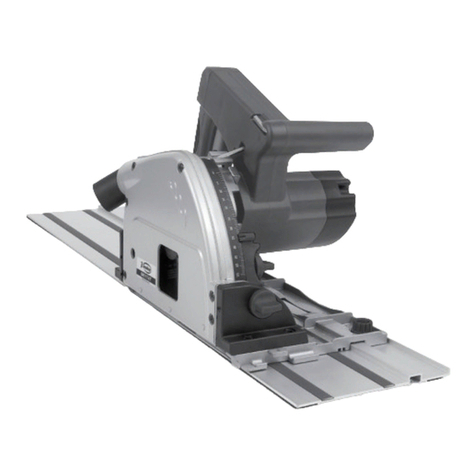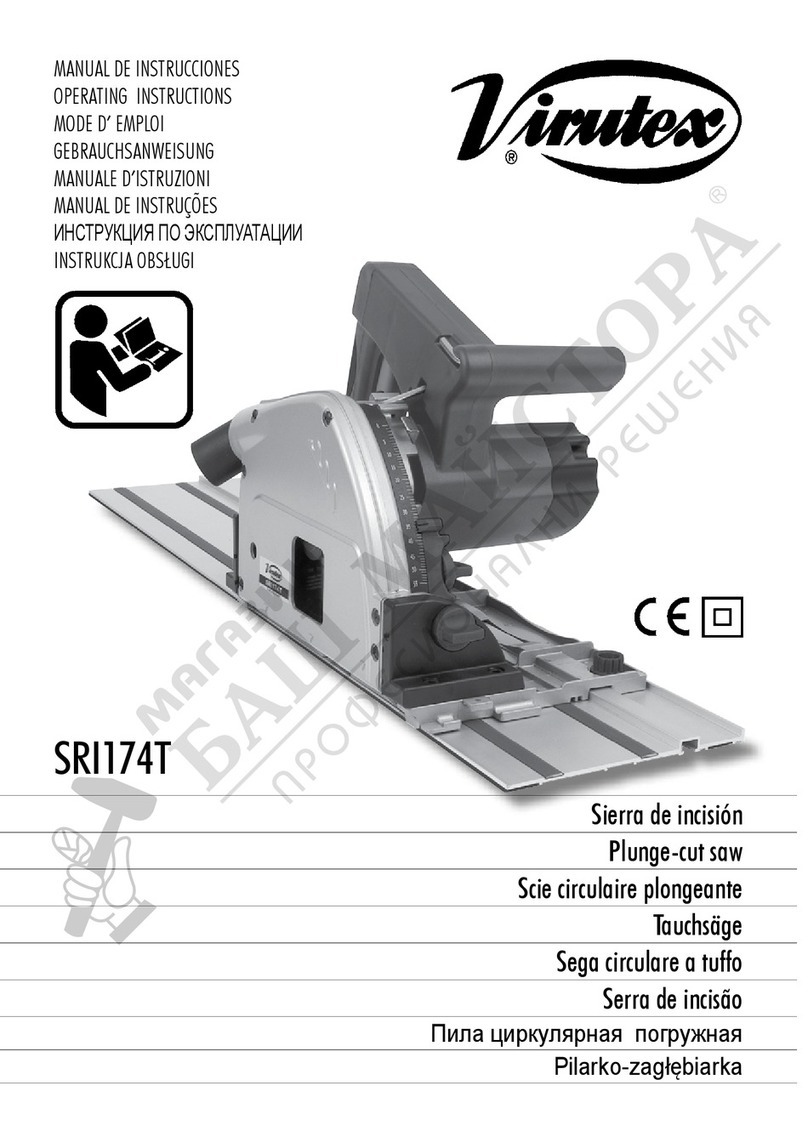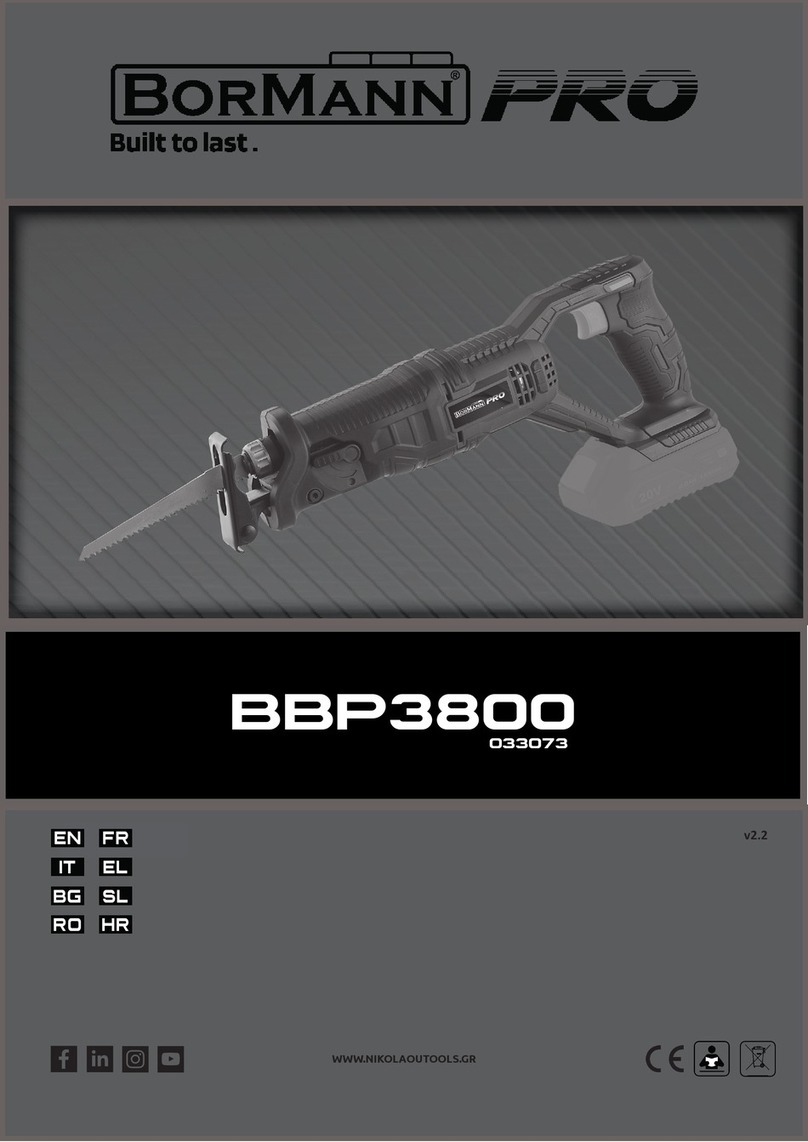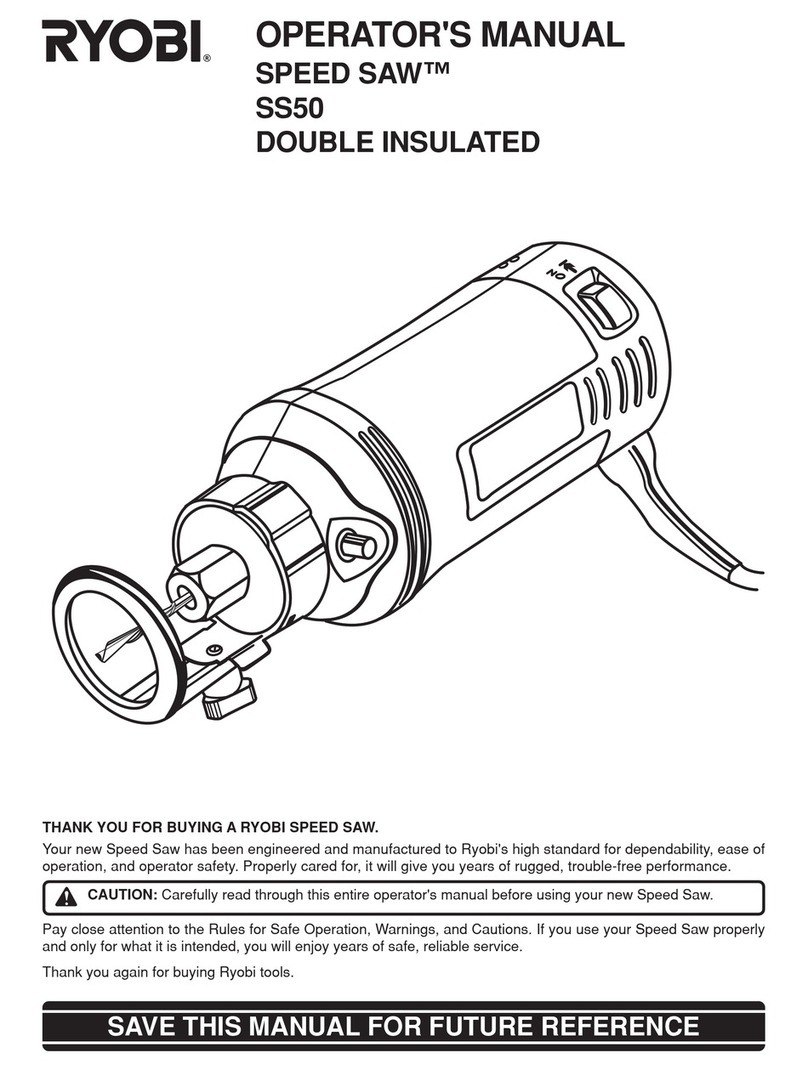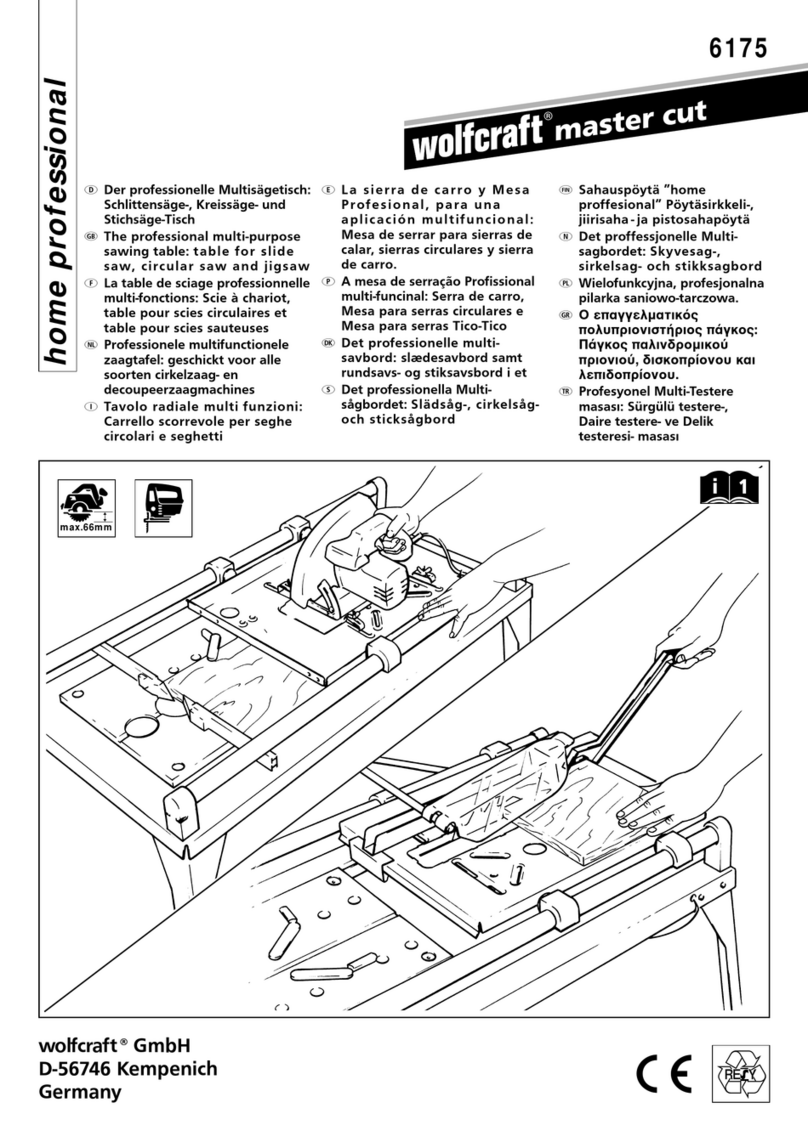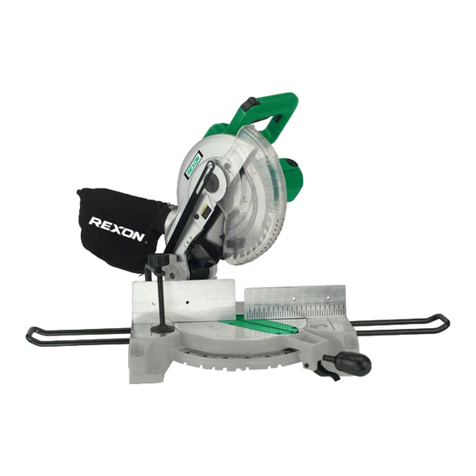Virutex SSB65 User manual

MANUAL DE INSTRUCCIONES
OPERATING INSTRUCTIONS
MODE D’ EMPLOI
GEBRAUCHSANWEISUNG
MANUALE D’ISTRUZIONI
MANUAL DE INSTRUÇÕES
ИНСТРУКЦИЯ ПО ЭКСПЛУАТАЦИИ
INSTRUKCJE OBSŁUGI
Sierra sable a batería
Cordless reciprocating saw
Scie Sabre à batterie
Akku-Säbelsäge
Sega a gattuccio
Serra sabre a bateria
Отрезная Беспроводная циркулярная пила
Отрезная Piła posuwowa szablasta akumulatorowa
SSB65

2
MANUAL DE INSTRUCCIONES
OPERATING INSTRUCTIONS
MODE D'EMPLOI
GEBRAUCHSANWEISUNG
MANUALE D'ISTRUZIONI
MANUAL DE INSTRUÇÕES
ИНСТРУКЦИЯ
ПО
ЭКСПЛУАТАЦИИ
INSTRUKCJA OBSŁUGI
página/page
Seite/pagina
страница/strona
ESPAÑOL Sierra sable a batería SSB65
5
ENGLISH SSB65 Cordless reciprocating saw
11
FRANÇAIS Scie Sabre à batterie SSB65
16
DEUTSCH Akku-Säbelsäge SSB65
22
ITALIANO Sega a gattuccio SSB65
29
PORTUGUÉS Serra sabre a bateria SSB65
35
РУССКИЙ Беспроводная циркулярная пила SSB65
41
POLSKI Piła posuwowa szablasta SSB65
48
Fig. 1
1
342
6
12 5
8
9
10

3
Fig. 4
Fig. 2
3
Fig. 6
12
4
Fig. 3
Fig. 5
9
10
5
7
11
10

4
Fig. 8
25*26*
2 Ah 4 Ah
Fig. 7
29*
34*
35*
36*
34*
34*
29*
36*
35*34*
9
25*26*
25*26*9
25*26*

5
ESPAÑOL
SIERRA SABLE A BATERÍA SSB65
Importante
1. INSTRUCCIONES DE SEGURIDAD
1.1INSTRUCCIONESGENERALESDESEGURIDAD
Antes de utilizar la máquina lea atenta-
menteésteMANUALDEINSTRUCCIONES
Asegúrese de haberlo comprendido antes
de empezar a operar con la máquina.
Conserve todas las advertencias e instrucciones para
referenciaenelfuturo. Eltérmino "herramientaeléctrica"
en las advertencias se refiere a la herramienta eléctrica
accionada por la red eléctrica (con cable) o a una he-
rramienta eléctrica accionada por batería (sin cable).
Lea estas instrucciones. La no observación
de todas las instrucciones relacionadas a
continuaciónpuededarcomoresultadoun
choqueeléctrico,fuegoy/o una lesiónseria.
1) Área de trabajo
a) Mantenga el área de trabajo limpia y bien iluminada.
Las áreas desordenadas y oscuras provocan accidentes.
b) No maneje herramientas eléctricas en atmósferas ex-
plosivas,tales comoenpresencia delíquidosinflamables,
gases o polvo. Las herramientas eléctricas crean chisaps
que pueden encender el polvo o humos.
c) Mantenga alejados a los niños y curiosos mientras
maneja una herramienta eléctrica. Las distracciones
pueden causarle la pérdida del control.
2) Seguridad eléctrica
a) La clavija de la herramienta eléctrica debe coincidir
con la base de la toma de corriente. No modificar nunca
la clavija de ninguna manera. No usar ningún adaptador
de clavijas con herramientas eléctricas puestas a tierra.
Clavijas no modificadas y bases coincidentes reducirán
el riesgo de choque eléctrico.
b) Evite el contacto del cuerpo con superficies puestas
a tierra como tuberías, radiadores, cocinas eléctricas y
refrigeradores. Hay un riesgo aumentado de choque
eléctrico si su cuerpo está puesto a tierra.
c) No exponga las herramientas eléctricas a la lluvia
o a condiciones de humedad. El agua que entre en la
herramienta aumentará el riesgo de choque eléctrico.
d) No abuse del cable. No usar nunca el cable para
llevar, levantar o desenchufar la herramienta eléctrica.
Mantenga el cable lejos del calor, aceite, cantos vivos
o piezas en moviento. Los cables dañados o enredados
aumnetan el riesgo de choque eléctrico.
e) Cuando maneje una herramienta eléctrica en el
exterior, use una prolongación de cable adecuada para
uso en el exterior. El uso de una prolongación de cable
adecuada para uso en el exterior reduce el riesgo de
choque eléctrico.
f) Si fuese imprescindible utilizar la herramienta eléc-
trica en un entorno húmedo, es necesario conectarla
a través de un fusible diferencial. La aplicación de un
fusible diferencial reduce el riesgo a exponerse a una
descarga eléctrica.
3) Seguridad personal
a) Esté alerta, vigile lo que está haciendo y use el sentido
común cuando maneje una herramienta eléctrica. No
use una herramienta eléctrica cuando esté cansado o
bajolainfluencia dedrogas, alcoholomedicamentos. Un
momento de distracción mientras maneja herramientas
eléctricas puede causar un daño personal serio.
b)Use equipode seguridad.Lleve siempreprotecciónpara
losojos.La utilizaciónpara lascondicionesapropiadas de
un equipo de seguridad tal como mascarilla antipolvo,
zapatos no resbaladizos, gorro duro, o protección para
los oídos reducirá los daños personales.
c) Evite un arranque accidental. Asegúrese de que el
interruptor está en posición “abierto” antes de enchufar
laclavija. Transportarherramientaseléctricasconeldedo
sobre el interruptor o enchufar herramientas eléctricas
que tienen en interruptor en posición “cerrado” puede
provocar accidentes.
d) Retire llave o herramienta antes de arrancar la herra-
mienta eléctrica. Una llave o herramienta dejada unida
a una pieza rotativa de una herramienta eléctrica puede
causar un daño personal.
e) No se sobrepase. Mantenga los pies bien asentados
sobre el suelo y conserve el equilibrio en todo momento.
Estopermite unmejorcontroldela herramientaeléctrica
en situaciones inesperadas.
f) Vista adecuadamente. No vista ropa suelta o joyas.
Mantenga su pelo, su ropa y guantes elejados de las
piezas en movimiento. La ropa suelta, las joyas o el pelo
largo pueden ser cogidos en las piezas en movimiento.
g) Si hay dispositivos para la conexión de medios de
extracción y recogida de polvo, asegúrese de que éstos
estén conectados y se usen correctamente. El uso de
estos dispositivos puede reducir los riesgos relacionados
con el polvo.
4) Utilización y cuidados de las herramientas eléctricas.
a)Nofuerce la herramientaeléctrica.Usela herramienta
eléctrica correcta para su aplicación. La herramienta
eléctrica correcta hará el trabajo mejor y más seguro
al ritmo para la que fue concebida.
b) No use la herramienta eléctrica si el interruptor no
actúa correctamente “cerrado” y “abierto”. Cualquier

6
herramienta eléctrica que no pueda controlarse con el
interruptor es peligrosa y debe repararse.
c) Desenchufe la clavija de la fuente de alimentación y
o batería antes de efectuar cualquier ajuste, cambio de
accesorios, o de almacenar las herramientas eléctricas.
Talesmedidaspreventivas deseguridad reducenelriesgo
de arrancar la herramienta accidentalmente.
d) Almacene las herramientas eléctricas inactivas fuera
del alcance de los niños y no permita el manejo de la
herramienta eléctrica a personas no familiarizadas con
las herramientas o con estas instrucciones. Las herra-
mientas eléctricas son peligrosas en manos de usuarios
no entrenados.
e) Mantega las herramientas eléctricas. Compruebe que
las partes móviles no estén desalineadas o trabadas, que
no haya piezas rotas u otras condiciones que puedan
afectarel funcionamientodelas herramientaseléctricas.
Las herramientas eléctricas se reparan antes de su uso,
cuando están dañadas. Muchos accidentes son causados
por herramientas eléctricas pobremente mantenidas.
f) Mantenga las herramientas de corte afiladas y limpias.
Las herramientas de corte mantenidas correctamente
con los bordes de corte afilados son menos probables
de trabarse y más fáciles de controlar.
g) Use la herramienta eléctrica, accesorios y puntas de
herramienta, etc de acuerdo con estas instrucciones y de
lamaneraprevista para eltipoparticular de herramienta
eléctrica,teniendo encuentalas condicionesdetrabajo y
el trabajo a desarrolar. El uso de la herramienta eléctrica
paraaplicaciones diferentesde lasprevistas podríacausar
una situación de peligro.
5) Servicio
a) Haga revisar su herramienta eléctrica por un servicio
de reparación cualifcado usando solamente piezas de
recambio idénticas. Esto garantizará que la seguridad
de la herramienta eléctrica se mantiene.
1.2 INSTRUCCIONES DE SEGURIDAD PARA EL
MANEJO DE LA SIERRA DE SABLE
Mantener las manos alejadas del área de
corte y de la hoja de sierra. Sujete con la
otra mano la empuñadura adicional o la
carcasa motor. Si la sierra se sujeta con
ambas manos, éstas no pueden lesionarse
con la hoja de sierra.
• No toque por debajo de la pieza de trabajo.
• Jamás sujete la pieza de trabajo con la mano o colo-
cándola sobre sus piernas. Fije la pieza de trabajo sobre
una plataforma estable.
Es importante que la pieza de trabajo quede bien sujeta
para reducir el riesgo de accidente, que se atasque el
disco de sierra, o perder del control sobre el aparato.
• Únicamente sujete la máquina por las empuñaduras
aisladas al realizar trabajos en los que el útil pueda tocar
conductores eléctricos ocultos o el propio cable de la
máquina. El contacto con conductores portadores de
tensiónpuedehacerque las partes metálicas delaparato
le provoquen una descarga eléctrica.
• Siempre use hojas de sierra de dimensiones correctas.
• Causas y prevención contra el retroceso de la sierra:
- El retroceso es una fuerza de reacción brusca que se
provoca al engancharse, atascarse o guiar incorrecta-
mente la hoja de sierra, lo que hace que la sierra se salga
de forma incontrolada de la pieza de trabajo y resulte
impulsada hacia el usuario.
- Si la hoja de sierra se engancha o atasca al cerrarse la
ranura de corte, la hoja de sierra se bloquea y el motor
impulsa la máquina hacia el usuario.
- Si la hoja de sierra se gira lateralmente o se desalinea,
los dientes pueden engancharse en la cara superior de la
pieza de trabajo haciendo que la hoja de sierra se salga
de la ranura de corte y resulte despedida hacia atrás en
dirección al usuario.
El retroceso es ocasionado por la aplicación o manejo
incorrecto de la herramienta eléctrica.
Esposibleevitarloateniéndosea lasmedidaspreventivas
que a continuación se detallan.
• Sujete firmemente la sierra con ambas manos man-
teniendo los brazos en una posición que le permita
oponerse a la fuerza de reacción. Mantenga el cuerpo
a un lado de la sierra y jamás colocándose en línea con
el. Aunque la sierra pueda retroceder bruscamente al
ser rechazada, el usuario puede controlar esta fuerza
de reacción tomando unas precauciones adecuadas.
• Si la hoja de sierra se atasca o si tuviese que inte-
rrumpir su trabajo, desconecte y mantenga la sierra sin
moverla en el material hasta que la hoja de sierra se haya
detenido completamente. Jamás intente sacar la sierra
de la pieza de trabajo o tirar de ella hacia atrás con la
hoja de sierra en funcionamiento, puesto que podría
ser rechazada. Localice y solucione convenientemente
la causa del atasco de la hoja de sierra.
• Para continuar el trabajo con la sierra, centrar primero
la hoja de sierra en la ranura y cerciorarse de que los
dientes de sierra no toquen la pieza de trabajo. Si la hoja
de sierra está atascada, la sierra puede llegar a salirse de
la pieza de trabajo o ser rechazada al ponerse en marcha.
• Sujete los tableros grandes para evitar que se atasque
la hoja de sierra y provoque un rechazo. Los tableros
grandes pueden moverse por su propio peso. Sujételos
a ambos lados, tanto cerca de la línea de corte como
por los bordes.
• No use hojas de sierra melladas ni dañadas.
Las hojas de sierra con dientes mellados o incorrecta-
mentetriscados producenuna ranurade cortedemasiado
estrecha,loque provoca unafricciónexcesiva y elatasco
o retroceso de la hoja de sierra.
Sea consciente y controle el tiempo que tarda la hoja

7
para papeles, monedas, llaves, clavos, tornillos, u otros
pequeños objetos matálicos que puedan establecer
una conexión de un terminal al otro. Un cortocircuito
entre ambos terminales de la batería puede ocasionar
quemaduras o un incendio.
• En condiciones abusivas, puede derramarse líquido de
la batería; evite el contacto. Si accidentalmente tiene
lugar un contacto, lávelo con agua. Si el líquido toca
a los ojos, busque ayuda medica adicionalmente. El
liquido derramado de la batería puede causar irritación
o quemaduras.
• No utilice baterías o útiles dañados o modificados. Las
baterías dañadas o modificadas puede comportarse de
forma imprevisible y no correcta y producir un fuego o
explosión y ocasionar un daño.
• Evite encendidos involuntarios. Asegurese que el
interruptor de encendido/apagado esté en la posición
de apagado antes de colocar la batería.
Llevar las herramientas eléctricas con el dedo en el
interruptor o insertar la batería con el interruptor en
posición encendido da lugar a accidentes.
• No abrir las baterías. Existe peligro de dañar el circuito.
• En caso de daños y uso indebido de la batería, pueden
emitirse vapores. En este caso sitúese en un lugar venti-
lado y busque asistencia médica en caso necesario. Los
vapores pueden irritar el sistema respiratorio.
• Cuando la batería esté defectuosa, el líquido puede
escapar y entrar en contacto con componentes adya-
centes. Revise las piezas correspondientes, límpielas o
reemplácelas si es necesario.
• Proteja la batería contra el calor, la irradiación solar
continua y el fuego. Existe peligro de explosión.
Leatodaslasinstrucciones y advertencias
de seguridad.
• Proteja el cargador de la batería de la lluvia y la
humedad. La entrada de agua en el mismo aumenta el
riesgo de descarga eléctrica.
• No cargue otras baterías. El cargador de la batería
sólo es adecuado para cargar baterías de iones de litio
dentro del rango de tensión indicado. De lo contrario,
existe peligro de incendio y explosión.
• Mantenga el cargador de la batería limpio. La suciedad
puede causar peligro de descarga eléctrica.
• Revise el cargador de la batería, el cable y el enchufe
siempre antes de usarlos. No utilice el cargador cuando
se detecten defectos. No abra el cargador por su cuenta,
hágalo reparar sólo por personal cualificado que utilice
repuestos originales. Los cargadores, los cables y los en-
chufesdañados aumentanelriesgodedescarga eléctrica.
• No utilice el cargador de la batería en superficies
fácilmente inflamables, por ejemplo, papel, textiles,
etc..., o en ambientes combustibles. Existe peligro de
incendio debido al calentamiento del cargador durante
de sierra en pararse después de soltar el interruptor.
• Utilice unos aparatos de exploración adecuados
para detectar posibles tuberías de agua y gas o cables
eléctricos ocultos. El contacto con cables eléctricos
puede electrocutarle o causar un incendio. Al dañar las
tuberías de gas, ello puede dar lugar a una explosión. La
perforación de una tubería de agua puede redundar en
daños materiales o provocar una electrocución.
• No utilice la herramienta eléctrica de forma estacio-
naria. Ésta no ha sido concebida para ser utilizada en
una mesa de corte.
• No sierre metales férricos. Las virutas incandescentes
pueden llegar a incendiar el equipo para aspiración
de polvo.
• Trabajar sobre una base firme sujetando la herramienta
eléctrica con ambas manos. La herramienta eléctrica es
guiada de forma más segura con ambas manos.
• Asegure la pieza de trabajo. Una pieza de trabajo fijada
con unos dispositivos de sujeción, o en un tornillo de
banco, se mantiene sujeta de forma mucho más segura
que con la mano.
• Antes de depositarla, esperar a que se haya detenido
la herramienta eléctrica. El útil puede engancharse y
hacerle perder el control sobre la herramienta eléctrica.
• No utilice la herramienta eléctrica si el cable está daña-
do. No toque un cable dañado, y desconecte el enchufe
de la red, si el cable se daña durante el trabajo. Un cable
dañado comporta un mayor riesgo de electrocución.
1.3 INSTRUCCIONES DE SEGURIDAD PARA EL
USO Y CUIDADO DE LA BATERÍA Y EL CARGADOR
Nocalientelabateríaporencimade45°C.
Protejala de una exposición prolongada
a los rayos de sol directos.
No deseche la batería en el fuego.
Proteja la batería de la lluvia.
• Recargue solamente con el cargador especificado por
el fabricante. Un cargador que es adecuado para un
tipo de bloque de baterías puede ocasionar un peligro
de incendio cuando se usa con otro bloque de baterías.
• Use las herramientas solamente con los bloques de
baterías diseñados específicamente. El uso de cualquier
otro bloque de baterías puede ocasionar un peligro de
daños e incendio.
• Cuando un bloque de baterías no esté en uso, man-
téngalo alejado de otros objetos metálicos como clips

8
el ciclo de carga.
2. CARACTERÍSTICAS
Tensión.................................................20 V Max.
Tipo de batería..........................................................Li-Ion
Tiempo de carga de la batería..............................60 min
Capacidad de la batería....................................2/4 Ah
Velocidad en vacío......................................0-2800/min
Profundidad de corte en madera.....................0-115 mm
Profundidad de corte en metal............................0-5 mm
Peso (sin batería).............................................................1,9 Kg
LpA:Presión acústica.....................................83,5 dB (A)
KpA:Incertidumbre.......................................................5 dB (A)
LWA:Potencia acústica....................................94,5 dB (A)
KWA:Incertidumbre.......................................................5 dB (A)
El impacto del ruido puede dañar la audoción. Valores
tonales de vibración (suma vectorial de tres direcciones)
según norma EN62841
Empuñadura
Vibración ponderada..............................................13,43 m/s2
Incertidumbre...........................................................K=1,5 m/s2
Empuñadura auxiliar
Vibración ponderada................................................17,4 m/s2
Incertidumbre..........................................................K=1,5 m/s2
3. RECOMENDACIONES
Respetarescrupulosamentelas instruccionescontenidas
en este manual, conservarlo con atención y tenerlo a
mano para eventuales controles de las partes indicadas.
Sise utilizalamáquina concuidado ysecumple elnormal
mantenimiento, su funcionamiento será prolongado.
Las funciones y el uso de la herramienta son sólo y exclu-
sivamente las indicadas en este manual. Está totalmente
prohibido cualquier otro uso de la herramienta.
Antes de montar la batería, comprobar siempre si el
interruptor de conexión/desconexión 4 (Fig. 1) trabaja
correctamentey regresaalaposiciónOFFcuandolosuelta.
4. COMPONENETES
DESCRIPCIÓN (Ver Fig. 9)
1. Empuñadura
2. Empuñadura auxiliar
3. Seguro
4. Interruptor
5. Cabezal
6. Palanca bloqueo
7. Hoja de sierra
8. Patín
9. Batería (no incluida)
10. Botón liberación batería
11. Cargador
12. Luz led
5. EQUIPO ESTÁNDAR
- Llave Allen
- Manual de instrucciones
- Garantía
6. CARACTERISTICAS DE LA MÁQUINA
La sierra de sable está diseñada para cortar piezas de
trabajohechas demadera, plásticoy metales(noferricos).
Lashojas desierra especialesextiendensignificativamen-
te el rango de aplicación de la herramienta eléctrica y
permiten el corte de diversos materiales, el corte curvo,
corte al ras, corte profundo, etc.
La batería 2 (Fig. 8) está protegida por el sistema de
seguridad contra descarga completa. En este caso, la
herramienta eléctrica se desconecta automáticamente.
No intente encender la herramienta
eléctrica cuando el sistema de protección
esté activado, la batería puede dañarse.
Indicadores del estado de carga de la batería (ver
Fig. 8)
Al pulsar el botón 25 los indicadores 26 mostrarán el
estado de carga de la batería.
7. PROCEDIMIENTO DE CARGA DE LA BATERÍA
Tiempo de carga de la bateria
Funcionamiento inicial de la herramienta eléctrica.
Antes del primer uso, la batería se debe cargar com-
pletamente.
Proceso de carga
• Presione el bloqueo de la batería 10 y retire la batería
9 (ver Fig. 2).
• Conecte el cargador 11 al suministro de energía (ver
Fig. 6).
• Inserte la batería en el cargador.
• Después de la carga, desconecte el cargador del su-
ministro de energía.
• Retire la batería del cargador y monte la batería en
la herramienta eléctrica (ver Fig. 2).
Indicadores del cargador (ver Fig. 7)
Los indicadores del cargador 34 y 35 informan sobre el
proceso de carga de la batería. Las señales de los indica-
dores 34 y 35 se muestran en la etiqueta 33 (ver Fig. 7).
• Fig. 7.1 - (El indicador verde 35 está iluminado, la
batería no está colocada en el cargador) – el cargador
está conectado a la red eléctrica (listo para cargar).
• Fig. 7.2 - (El indicador verde 35 está parpadeando,
la batería está colocada en el cargador) – la batería se
está cargando.
• Fig. 7.3 - (El indicador verde 35 está iluminado, la
batería está colocada en el cargador) - la batería está
completamente cargada.
• Fig. 7.4 - (El indicador rojo 34 está iluminado, la batería

9
está colocada en el cargador) - el proceso de carga de
la batería se ha interrumpido debido a una temperatura
inadecuada.Cuando lascondiciones detemperaturasean
normales, el proceso de cargar se reanudará.
• Fig. 7.5 - (El indicador rojo 34 está parpadeando, la
batería está colocada en el cargador) – el proceso de
carga de la batería se ha interrumpido debido a un
fallo en la misma. Sustituya la batería defectuosa está
prohibido su posterior uso.
Durante el proceso de carga, la batería y el cargador se
calientan, esto es un proceso normal.
8. PUESTA EN MARCHA
8.1Apretar elbotóndedesbloqueo3 ypresionarelgatillo
del interruptor de conexión /desconexión 4 (Fig. 4). Al
soltar la presión sobre el mismo, la máquina se para.
8.2 Control de velocidad variable
El control de velocidad variable es posible con
el interruptor de encendido / apagado (4).
Amayor presiónsobreelinterruptoraumentalavelocidad
8.3 Trabajo con la sierra alternativa
Sostenga siempre la máquina por sus dos empuñaduras
con ambas manos.
Encienda la sierra para alcanzar su velocidad máxima.
Apoye el patín de la sierra 8 en la pieza de trabajo que
desee aserrar.
Luego mueva lentamente la hoja de sierra a lo largo del
línea de corte. Utilice hojas de sierra especificas para el
tipo de material a cortar
9. MONTAJE DE LA HOJA DE SIERRA
Quitar la batería de la máquina antes de
efectuar cualquier trabajo en la misma.
PRECAUCIÓN: No usar hojas de sierra deformadas o
deterioradas.Nousar hojasdesierra queno cumplan con
las características especificadas en estas instrucciones.
Inserción / reemplazo de la hoja de sierra (ver Fig. 3)
Como resultado del uso prolongado, la hoja de sierra
puede calentarse bastante y los bordes de corte afilados
pueden lesionar al usuario.
Antesderetirarla hoja desierraasegúrese
de que se haya enfriado lo suficiente
después del trabajo. Deberá utilizar
siempre guantes protectores al insertar/
reemplazar la hoja de sierra
Gire el cabezal de fijación 5 (Fig. 3) y manténgala en
esta posición para sacar o colocar la hoja de sierra,
inserte el vástago de la hoja de sierra en el soporte de
la hoja de sierra.
Revise que la hoja de sierra 10 esté bien ajustada
tirando de ella.
Si está fijada de manera insegura, la hoja
de sierra puede provocar lesiones. Se
permite instalar la hoja de sierra con los
dientes hacia arriba; esto puede ser re-
querido para tipos específicos de trabajo.
10. AJUSTES
Placa de soporte (ver Fig. 1)
La placa de soporte 8 facilita el trabajo con la sierra al
hacer que la hoja de sierra trabaje en forma perpendi-
cular con respecto al lugar de trabajo y también sirve
como detención del corte, adaptándose a la posición
del material cortado.
Para mover el soporte de la placa 8 hacia delante o hacia
atrás, haga lo siguiente:
Libere la fijación del patin mediante la palanca 6 y
situe el patín a la posición deseada posteriormente
vuelva a bloquear el patin retornando la palanca a la
posición de incio.
Rotación del cuerpo de la máquina
Lasierra vaprovistadeunsistema quepermite larotación
del cuerpo de la máquina sobre la empuñadura (90º, 0º
y -90º) para poder acceder con facilidad a cualquier
posición de trabajo.
11. MANTENIMIENTO
Quitar la batería de la máquina antes de
efectuar cualquier trabajo en la misma.
- Inspección de la hoja de sierra. Los restos de resina
y cola sobre de la hoja de sierra son causa de cortes
deficientes. Limpiar la hoja de sierra inmediatamente
después de su uso.
- Inspeccionar el cabezal de montaje. Regularmente
inspeccionar todos los tornillos de montaje y asegu-
rarse de que estén apretados firmemente. Si cualquier
componente estuviera suelto, volver a apretarlo inme-
diatamente. El no hacer esto provocaría un riesgo serio.
- Mantenimiento del motor. Prestar el mayor cuidado
y asegurarse de que el bobinado del motor no se dañe
y/o se humedezca con aceite o agua.
- Mantener siempre libres y limpias las aberturas de
ventilación.
- Limpiar esmeradamente la máquina después de utili-
zarla. Soplar regularmente el motor con aire a presión.
- Sólo se deben utilizar accesorios y piezas de repuesto
Virutex. Las piezas cuyo recambio no esté descrito en
estasinstrucciones deuso,deben sustituirseenun centro

10
de asistencia técnica Virutex.
12. MANTENIMIENTO DE LA BATERIA
Mantenimiento de la herramienta eléctrica/medidas
preventivas
Antes de realizar cualquier trabajo en la herramienta
eléctrica, quite la batería.
Instrucciones de mantenimiento de la batería
• Realice la carga oportunamente, antes de que la ba-
tería 9 (Fig. 8) esté completamente agotada. Detenga la
operación en baja energía y cárguela inmediatamente.
• No sobrecargue la batería cuando la misma esté
completamente cargada, de lo contrario se acortará
su vida útil.
• Cargue la batería a temperatura ambiente de 10ºC a
40ºC (50ºF a 104ºF). Una carga inadecuada a tempera-
turas fuera del margen indicado puede dañar la bateria
y aumentar el riesgo de incendio.
• Cargue la batería cada 6 meses si estuvo sin funcio-
namiento durante un tiempo prolongado.
• Sustituya las baterías usadas a tiempo. La disminución
de la producción o un tiempo de ejecución significati-
vamente más corto de la herramienta eléctrica después
de la carga, indica que la batería se ha gastado y que
se necesita reemplazarla. Se debe tener en cuenta que
la batería puede descargarse más rápido si los trabajos
tienen con temperaturas inferiores a 0°C.
• En caso de almacenamiento sin uso durante un tiempo
prolongado, se recomienda guardar la batería a tempe-
ratura ambiente y se debe cargar al 50%.
Servicio:
a) Haga revisar su herramienta eléctrica por un servicio
de reparación cualificado usando solamente piezas de
recambio idénticas. Esto garantizará que la seguridad
de la herramienta eléctrica se mantiene.
b)No reparelos Acumuladoresdañados. Elmantenimien-
to de las baterias y acumuladores sólo debe ser realizado
por el fabricante o un servicio técnico autorizado.
Transporte de baterías de Li-Ion
Las baterías de Li-Ion incorporadas están sujetas a los
requisitos de la Legislación de mercaderías peligrosas.
El usuario puede transportar las baterías por carretera
sin más requisitos.
Cuando se transporta por terceros (por ejemplo: trans-
porteaéreo oempresade transportes),sedeben observar
los requisitos especiales sobre embalaje y etiquetado.
Para preparar el elemento que se envía, es necesario
consultar a un experto en materiales peligrosos.
Envíe las baterías sólo cuando la carcasa esté en buen
estado. Coloque cinta o tape los contactos abiertos y
embale la batería de manera tal que no pueda moverse
en el embalaje. Tenga también en cuenta las normativas
nacionales que pueden ser más detalladas.
13. NIVEL DE RUIDO Y VIBRACIONES
Los niveles de ruido y vibraciones de esta herramienta
eléctrica han sido medidos de acuerdo con la Norma
Europea EN62841 y sirven como base de comparación
con máquinas de semejante aplicación.
El nivel de vibraciones indicado ha sido determinado
para las aplicaciones principales de la herramienta,
y puede ser utilizado como valor de partida para la
evaluación de la exposición al riesgo de las vibraciones.
Sin embargo, el nivel de vibraciones puede llegar a ser
muy diferente al valor declarado en otras condiciones
de aplicación, con otros útiles de trabajo o con un
mantenimiento insuficiente de la herramienta eléctrica
y sus útiles, pudiendo llegar a resultar un valor mucho
más elevado debido a su ciclo de trabajo y modo de uso
de la herramienta eléctrica.
Por tanto, es necesario fijar medidas de seguridad de
protección al usuario contra el efecto de las vibraciones,
como pueden ser mantener la herramienta y útiles de
trabajo en perfecto estado y la organización de los
tiempos de los ciclos de trabajo (tales como tiempos
de marcha con la herramienta bajo carga, y tiempos de
marcha de la herramienta en vacío y sin ser utilizada
realmente ya que la reducción de estos últimos puede
disminuirde formasustancial elvalortotaldeexposición).
14. GARANTÍA
Todas las herramientas eléctricas VIRUTEX, tienen una
garantíaválidade 12mesesa partirdel día desuministro,
quedando excluidas todas las manipulaciones o daños
ocasionados por manejos inadecuados o por desgaste
natural de la máquina. Para cualquier reparación, diri-
girse al servicio oficial de asistencia técnica de Virutex.
15. RECICLAJE DE LAS HERRAMIENTAS ELÉC-
TRICAS
Nunca tire la herramienta eléctrica con el resto de resi-
duos domésticos. Recicle las herramientas, accesorios y
embalajes de forma respetuosa con el medio ambiente.
Respete la normativa vigente de su país.
Aplicable en la Unión Europea y en países europeos con
sistemas de recogida selectiva de residuos:
La presencia de esta marca en el producto o en el
material informativo que lo acompaña, indica que al
finalizar su vida útil no deberá eliminarse junto con
otros residuos domésticos.
No deseche la batería en un recipiente
de basura doméstico.
Conforme a la Directiva Europea 2002/96/CE los usuarios
puedencontactar conel establecimientodonde adquirie-
ronel producto,oconlasautoridades localespertinentes,
para informarse sobre cómo y dónde pueden llevarlo

11
para que sea sometido a un reciclaje ecológico y seguro.
VIRUTEXse reservaelderecho demodificar susproductos
sin previo aviso.
ENGLISH
SSB65 CORDLESS RECIPROCATING SAW
Warning
1. SAFETY INSTRUCTIONS
1.1 GENERAL SAFETY INSTRUCTIONS
Read these OPERATING INSTRUCTIONS.
Makesureyouhaveunderstoodthem befo-
re operating the machine for the first time.
Save all warnings and instructions for future reference.
Theterm “powertool”inthewarnings referstothepower
tool run off the electrical network (with a power cord)
or to a battery run power tool (cordless).
Read all instructions. Failure to follow
all instructions listed below may result
in electric shock, fire and/or serious
injury. The term “power tool” in all of
the warnings listed below refers to your
mains operated (corded) power tool or
battery operated (cordless) power tool.
1) Work area
a) Keep work area clean and well lit. Cluttered and dark
areas invite accidents.
b) Do not operate power tools in explosive atmospheres,
such as in the presence of flammable liquids, gases or
dust. Power tools create sparks which may ignite the
dust or fumes.
c) Keep children and bystanders away while operating a
power tool. Distractions can cause you to lose control.
2) Electrical safety
a) Power tool plugs must match the outlet. Never modify
the plug in any way. Do not use any adapter plugs with
earthed (grounded) power tools. Unmodified plugs and
matching outlets will reduce risk of electric shock.
b) Avoid body contact with earthed or grounded sur-
faces such as pipes, radiators, ranges and refrigerators.
There is an increased risk of electric shock if your body
is earthed or grounded.
c) Do not expose power tools to rain or wet conditions.
Water entering a power tool will increase the risk of
electric shock.
d)Donot abuse thecord.Never use thecordfor carrying,
pulling or unplugging the power tool. Keep cord away
from heat, oil, sharp edges or moving parts. Damaged
or entangled cords increase the risk of electric shock.
e) When operating a power tool outdoors, use an
extension cord suitable for outdoor use. Use of a cord
suitablefor outdoorusereducestherisk ofelectricshock.
f) If operating a power tool in a damp location is una-
voidable, use a residual current device (RCD) protected
supply. Use of an RCD reduces the risk of electric shock.
3) Personal safety
a) Stay alert, watch what you are doing and use com-
mon sense when operating a power tool. Do not use a
power tool while you are tired or under the influence
of drugs, alcohol or medication. A moment of inatten-
tion while operating power tools may result in serious
personal injury.
b) Use safety equipment. Always wear eye protection.
Safety equipment such as dust mask, non-skid safety
shoes, hard hat, or hearing protection used for appro-
priate conditions will reduce personal injuries.
c) Avoid accidental starting. Ensure the switch is in the
off position before plugging in. Carrying power tools
with your finger on the switch or plugging in power
tools that have the switch on invites accidents.
d) Remove any adjusting key or wrench before turning
the power tool on. A wrench or a key left attached to a
rotating part of the power tool may result in personal
injury.
e) Do not overreach. Keep proper footing and balance
at all times. This enables better control of the power
tool in unexpected situations.
f)Dressproperly. Donotwear looseclothing or jewellery.
Keep your hair, clothing and gloves away from moving
parts. Loose clothes, jewellery or long hair can be caught
in moving parts.
g) If devices are provided for the connection of dust
extraction and collection facilities, ensure these are
connected and properly used. Use of these devices can
reduce dust related hazards.
4) Power tool use and care
a) Do not force the power tool. Use the correct power
tool for your application. The correct power tool will
do the job better and safer at the rate for which it
was designed.
b) Do not use the power tool if the switch does not turn
it on and off. Any power tool that cannot be controlled
with the switch is dangerous and must be repaired.
c) Disconnect the plug from the power source before
makingany adjustments,changing accessories,or storing
powertools.Such preventivesafety measuresreducethe
risk of starting the power tool accidentally.
d) Store idle power tools out of the reach of children

12
and do not allow persons unfamiliar with the power tool
or these instructions to operate the power tool. Power
tools are dangerous in the hands of untrained users.
e) Maintain power tools. Check for misalignment or
bindingof movingparts,breakage ofparts andanyother
condition that may affect the power tools operation. If
damaged,havethe powertool repairedbeforeuse. Many
accidents are caused by poorly maintained power tools.
f) Keep cutting tools sharp and clean. Properly maintained
cutting tools with sharp cutting edges are less likely to
bind and are easier to control.
g) Use the power tool, accessories and tool bits etc, in
accordance with these instructions and in the manner
intended for the particular type of power tool, taking
into account the working conditions and the work to be
performed.Use ofthepowertoolfor operationsdifferent
fromthose intendedcouldresultinahazardoussituation.
5) Service
a) Have your power tool serviced by a qualified repair
person using only identical replacement parts. This will
ensure that the safety of the power tool is maintained.
1.2 SAFETY INSTRUCTIONS FOR
HANDLING THE RECIPROCATING SAW
Keep hands away from cutting area and
the blade. Keep your second hand on
auxiliary handle, or motor housing. If
both hands are holding the saw, they
cannot be cut by the blade.
• Do not reach underneath the workpiece.
• Never hold the workpiece being cut in your hands
or across your leg. Secure the workpiece to a stable
platform. It is important to support the work properly
to minimize body exposure, blade binding, or loss of
control.
• Hold the power tool only by the insulated gripping
surfaces when performing an operation where the cut-
ting tool may contact hidden wiring or its own cord.
Contact with a “live” wire will also make exposed metal
parts of the power tool “live” and shock the operator.
• Always use blades with correct size.
• Causes and operator prevention of kickback:
– Kickback is a sudden reaction to a pinched, bound
or misaligned blade, causing an uncontrolled saw to
lift up and out of the workpiece toward the operator.
– When the blade is pinched or bound tightly by the
kerf closing down, the blade stalls and the motor reac-
tion drives the unit rapidly back toward the operator.
– If the blade becomes twisted or misaligned in the
cut, the teeth at the back edge of the blade can dig
into the top surface of the wood causing the blade
to climb out of the kerf and jump back toward the
operator.
Kickback is the result of saw misuse and/or incorrect
operating procedures or conditions and can be avoided
by taking proper precautions as given below.
• Maintain a firm grip with both hands on the saw and
position your arms to resist kickback forces. Position
your body to either side of the blade, but not in line
with the blade. Kickback could cause the saw to jump
backwards, but kickback forces can be controlled by
the operator, if proper precautions are taken.
• When blade is binding, or when interrupting a cut
for any reason, release the trigger and hold the saw
motionless in the material until the blade comes to a
complete stop. Never attempt to remove the saw from
the work or pull the saw backward while the blade is
in motion or kickback may occur.
Investigate and take corrective actions to eliminate
the cause of blade binding.
• When restarting a saw in the workpiece, centre the
blade in the kerf and check that saw teeth are not
engaged into the material. If blade is binding, it may
walk up or kickback from the workpiece as the saw is
restarted.
• Support large panels to minimise the risk of blade
pinching and kickback. Large panels tend to sag under
their own weight. Supports must be placed under the
panel on both sides, near the line of cut and near the
edge of the panel.
• Do not use jagged or damaged blades. Unsharpened
or improperly set blades produce narrow kerf causing
excessive friction, blade binding and kickback.
• Be aware of the time it takes for the blade to stop
after switch is released.
• Use suitable detectors to determine if utility lines
are hidden in the work area or call the local utility
company for assistance. The contact with electric lines
can lead to fire and electric shock. Damaging a gas line
can lead to explosion. Penetrating a water line causes
property damage or may cause an electric shock.
• Do not operate the power tool stationary. It is not
designed for operation with a saw table.
• Do not saw ferrous metals. Red hot chips can ignite
the dust extraction.
• When working with the machine, always hold it fir-
mly with both hands and provide for a secure stance.
The power tool is guided more secure with both hands.
• Secure the workpiece. A workpiece clamped with
clamping devices or in a vice is held more secure than
by hand.
• Always wait until the machine has come to a com-
plete stop before placing it down. The tool insert can
jam and lead to loss of control over the power tool.
• Never use the machine with a damaged cable. Do
not touch the damaged cable and pull the mains plug
when the cable is damaged while working. Damaged
cables increase the risk of an electric shock.

13
1.3 SAFETY INSTRUCTIONS FOR USE AND MAIN-
TENANCE OF THE BATTERY AND CHARGER
Donotstorethe tool andbatterycartridge
in locations where the temperature may
reach or exceed 45° C.
Do not incinerate the battery cartridge.
Do not expose battery cartridge to water
or rain.
• Only recharge with the manufacturer's specified
charger. Only recharge with the manufacturer's speci-
fied charger. A charger which is suitable for one type
of battery cartridge can cause a fire risk on another
type of battery cartridge.
• Only use this power tool with the battery cartridge
specifically designed for this model. The use of other
types of battery cartridges may cause injury to the
operator and a fire risk.
• When the battery cartridge is not in use, keep it
away from metal objects, such as paper clips, coins,
keys, nails, screws or other small metal objects that
can establish
contact from one terminal to the other. Shorting the
battery terminals may cause burns or a fire.
• Battery fluid may be spilled under extreme condi-
tions; avoid contact with this liquid. In case of acci-
dental contact, rinse thoroughly with water. If the
liquid comes into contact with your eyes, seek medical
attention. Battery fluid may cause irritation or burns.
• Do not use damaged or modified batteries. Damaged
or modified batteries can behave in an unpredictable
way and may cause injury to the operator and a fire
risk.
• Avoid switching the device on accidentally. Make
sure the on/off switch is in the off position before in-
serting the battery. Carrying the power tool with your
finger on the on/off switch or inserting the battery
with the switch in the on position can cause accidents.
• Do not open the batteries. You could damage the
circuits.
• Fumes may be aired if there is battery damage and
improper use. In this case, go to a well-ventilated lo-
cation and seek medical assistance, if necessary. Fumes
cause respiratory irritation.
• When the battery is defective, the liquid may leak
and come into contact with adjacent components.
Check the corresponding parts. Clean or replace them,
if necessary.
• Protect the battery from heat, continued solar radia-
tion and fire. There is an explosion hazard.
Readallinstructionsandsafetywarnings.
• Protect the battery charger from rain and moisture.
Water entering the charger increases the risk of elec-
tric shock.
• Do not charge other batteries. The battery charger is
only suitable for charging lithium-ion batteries within
the indicated voltage range. Otherwise, there is a fire
and explosion hazard.
• Keep the battery charger clean. Dirt can cause a risk
of electric shock.
• Always check the battery charger, its cable and plug
before using them. Do not use the charger if you see
it is damaged. Do not open the charger on your own.
Have it repaired by a qualified person who uses origi-
nal spare parts. Damaged chargers, cables and plugs
increase the risk of electric shocks.
• Do not use the battery charger on highly flammable
surfaces. For example, paper, textiles, etc., or in com-
bustible environments. A fire hazard exists from the
charger heating during the charging cycle.
2. SPECIFICATIONS
Battery voltage.........................................................20 V Max
Battery type......................................................................Li-Ion
Time to charge battery..................................................60 min
Batterycapacity..............................................................2 or4Ah
No-load speed.................................................0-2,800/min
Depth of cut capacity in wood......................0-115 mm
Depth of cut capacity in metal..........................0-5 mm
Weightwithout battery....................................................1.9 Kg
LpA:Sound pressure.............................................83,5 dB (A)
KpA:Uncertainty.........................................................5 dB (A)
LWA:Acoustic power............................................94,5 dB (A)
KWA:Uncertainty.....................................................5dB (A)
! Wear ear protection.
The vibration total value (tri-axial vector sum) deter-
mined according to EN60745.
Handle
Vibration emission.................................................13,43 m/s2
Uncertainty..............................................................K=1,5 m/s2
Auxiliary handle
Vibrationemission.......................................................17,4m/s2
Uncertainty..............................................................K=1,5 m/s2
3. RECOMMENDATIONS
Follow very carefully the instructions in this manual,
save itand keep it close at hand, ready to carry out any
inspection of parts that may be necessary.
If the tool is used with care and normal maintenance is

14
carried out, it will work well for a long time.
The functions and use of the tool you have bought shall
be only those described in thi this manual. Any other
use of the tool is strictly forbidden.
Beforeinsertingthebatterycartridgeintothetool,always
check to see that the On/Off trigger 4 (Fig. 1) actuates
properlyand returnstothe "OFF"position whenreleased.
4. COMPONENTS
DESCRIPTION (See Fig. 9)
1. Handle
2. Auxiliary handle
3. Lock-on button
4. Switch
5. Head
6. Bolt
7. Blade
8. Support plate
9. Battery (not included)
10. Battery lock-off button
11. Charger
12. LED light
5. STANDARD EQUIPMENT
- Allen key
- Instructions manual.
- Warranty
6. SPECIFICATIONS OF THE TOOL
The cordless reciprocating saw is designed for cutting
wooden, plastic and metal (non ferrous) workpieces.
Special saw blades extend significantly the application
range of the power tool and allows for cutting various
materials,curved sawing,flushcutting,deepcutting, etc.
Overdischarge protection
The battery 2 (Fig. 8) is protected by the safety system
against deep discharge. In case of complete discharge,
the power tool is automatically switched off.
Do not try to switch on the power tool
when the protection system is activated
the battery can be damaged.
Indicators of the state of battery charge (see Fig. 8)
With the push of the button 25 the indicators 26 show
the state of charge of the battery.
7. HOW TO CHARGE THE BATTERY
Battery charging time
Initial operating of the power tool
Before the first use, the battery must be fully charged.
Charging process
• Press the battery lock 10 and remove the battery 9
(see Fig. 2).
• Connect the charger 11 to the power supply (see Fig. 6).
• Insert battery into charger.
• Disconnect the charger from power supply after
charging.
• Remove the battery from the charger and mount
battery in the power tool (see Fig. 2).
Charger indicators (see Fig. 7)
Charger indicators 34 and 35 inform of the battery
charging process. Signals of the indicators 34 and 35
are shown on the label 33. (see Fig. 7).
• Fig. 7.1 - (The green indicator 35 is on, the battery is
not inserted in the charger) - the charger is connected
to the power network (ready for charging).
• Fig. 7.2 - (The green indicator 35 is blinking, the battery
is inserted in the charger) - the battery is being charged.
• Fig. 7.3 - (The green indicator 35 is on, the battery is
inserted in the charger) - the battery is fully charged.
• Fig. 7.4 - (The red indicator 34 is on, the battery is
inserted in the charger) - the charging process of the
battery is terminated due to inappropriate temperature.
Whenthe temperatureconditions arenormal, theprocess
of charging will resume.
• Fig. 7.5 - (The red indicator 34 is blinking, the battery
is inserted in the charger) - the charging process of the
battery is terminated because of its failure. Replace the
faulty battery, its further use is prohibited.
In the process of charging the battery and the charger
become hot, it is a normal process.
8. TURNING ON THE MACHINE
8.1 Press the on / off lock button 4 (Fig. 4). By releasing
the pressure on it, the machine stops.
8.2 Variable speed control
Variable speed control is possible with the on / off
switch 4.
Higher pressure on the switch increases the speed.
8.3 Working with the reciprocating saw
Always hold the machine by its two handles with both
hands. Start the saw to reach its full speed.
Rest the saw blade 8 on the workpiece that you want
to saw.
Then slowly move the saw blade along the cutting line.
Use specific saw blades for the type of material to be cut.
9. FITTING THE SAW BLADE
Remove the battery from the power
tool before carrying out work on the
power tool.

15
CAUTION: Do not use bent or cracked blades. Do not use
saw blades that do not conform to the specifications
contained in these instructions.
Inserting / replacing the saw blade (see Fig. 3)
As a result of prolonged use, the saw blade can get quite
hot and sharp cutting edges they can injure the user.
Beforeremovingthesawblademakesure
that it has cooled enough after work.
You will need to use always protective
gloves when inserting / replace saw blade
Rotate the fixing head 5 (Fig. 3) and hold it in this
position to remove or insert the saw blade, insert stem
of the blade in the holder of the blade.
Checkthattheblade10isproperlyadjustedby pullingher.
If it is not correctly fixed, blade can
cause injury. It is allowed to install the
blade with the teeth upwards; this may
be required for for specific types of work.
10. SETTINGS
Support plate (see Fig. 1)
The support plate 8 facilitates work with the power tool,
it provides perpendicularity of the saw blade towards
the workplace and also serves as sawing stop allowing
adapting to sawed position.
To move the support plate 8 forward or backward, do
the following:
Loose the bolt 6 and set the support plate into required
position. Use the allen key to tighten bolts.
Rotation of the machine body
The saw is provided with a system that allows rotation
of the body of the machine on the handle (90º, 0º and
-90º) to adjust easily to any work position.
11. MAINTENANCE
Remove the battery from the power tool
beforecarryingoutworkon the power tool.
- Check the saw blade. Deposits of resin and glue on
the saw blade cause inefficient cutting. To avoid them,
always clean the blade immediately after use.
- Inspect the head. Regularly inspect all the mounting
screws and ensure they are firmly tightened. Should any
component be loose, tighten it immediately. Failure to
do so could put you at serious risk.
- Motor maintenance. Always take the greatest care
over this and make sure that the motor winding is not
damaged and does not become wet with oil or water.
- The vents should always be kept clean and free of
obstacles.
- Clean the machine thoroughly after each use. Blast
the motor regularly with compressed air.
- Use only Virutex accessories and spares. Parts the chan-
ging of which is not showed in this instruction manual,
should be replaced in a Virutex official service centre.
12. BATTERY MAINTENANCE
Maintenance of the electric tool / preventive measures
Remove the battery from the power tool before carrying
out work on the power tool.
Battery maintenance instrucions
• Charge the battery cartridge 9 (Fig. 8) before com-
pletely discharged. Stop operation in low power and
charge it immediately.
• Do not overcharge when the battery is full, other-wise
it will shorten the life time.
• Charge the battery cartridge with room temperature
at 10° C - 40° C (50°F to 104°F). Charging the battery
in temperatures out of this range can damage it and
may cause fire.
• Charge battery every 6 months without operation
for a long time.
• Replace worn out batteries in time. Decline of pro-
duction or a significantlyshorter runtime of the power
toolafter chargingindicatesaging ofthebattery andthe
need for replacement. It should be taken into account
that the battery may discharge faster if the works take
place in the temperature below 0°.
• In case of long time storage without use, it is recom-
mended to store the battery at room temperature, it
should be charged to 50%.
Technical service:
a) To maintain product safety and reliability, repairs, any
other maintenance or adjustment should be performed
by authorized service senters, always using original
replacement parts.
b) Do not repair damaged batteries. Maintenance of the
batteries should be performed only by their producer or
authorized service center.
Transport of Li-Ion batteries
The contained Li-Ion batteries are subject to the
Dangerous Goods Legislation requirements. The user
can transport the batteries by road without further
requirements.
When being transported by third parties (e.g.: air trans-
port or forwarding agency), special requirements on
packaging and labelling must be observed. For prepa-
ration of the item being shipped, consulting an expert
for hazardous material is required.
Dispatchbatteries onlywhenthe housingisundamaged.
Tape or mask off open contacts and pack up the battery

16
in such a manner that it cannot move around in the
packaging. Please also observe possibly more detailed
national regulations
13. NOISE AND VIBRATION LEVEL
The noise and vibration levels of this device have
been measured in accordance with European standard
EN62841 and serve as a basis for comparison with other
machines with similar applications.
The indicated vibration level has been determined for
the device’s main applications and may be used as an
initial value for evaluating the risk presented by expo-
sure to vibrations. However, vibrations may reach levels
that are quite different from the declared value under
other application conditions, with other tools or with
insufficient maintenance of the electrical device or its
accessories, reaching a much higher value as a result
of the work cycle or the manner in which the electrical
device is used.
Therefore, it is necessary to establish safety measures
to protect the user from the effects of vibrations, such
as maintaining both the device and its tools in perfect
condition and organising the duration of work cycles
(such as operating times when the machine is subjected
toloads, andoperating timeswhenworkingwithno-load,
in effect, not in use, as reducing the latter may have a
considerable effect upon the overall exposure value).
14. WARRANTY
All VIRUTEX power tools are guaranteed for 12 months
from the date of purchase, excluding any damage which
is a result of incorrect use or of natural wear and tear
on the machine. All repairs should be carried out by the
official VIRUTEX technical assistance service.
15. RECYCLING ELECTRICAL EQUIPMENT
Neverdispose ofelectrical equipmentwith domesticwas-
te.Recycle equipment,accessoriesandpackagingin ways
that minimise any adverse effect on the environment.
Comply with the current regulations in your country.
Applicable in the European Union and in European
countries with selective waste collection systems:
If this symbol appears on the product or in the accom-
panying information, at the end of the product's useful
lifeitmust notbedisposed ofwith other domesticwaste.
Donotdisposeof the battery inadomestic
waste container
In accordance with European Directive 2002/96/EC, users
maycontact theestablishment wherethey purchasedthe
productortherelevantlocal authority to find out where
and how they can take the product for environmentally
friendly and safe recycling.
VIRUTEX reserves the right to modify its products
without prior notice.
FRANÇAIS
SCIE SABRE À BATTERIE SSB65
Important
1. CONSIGNES DE SÉCURITÉ
1.1 CONSIGNES GÉNÉRALES DE SÉCURITÉ
Avant d'utiliser la machine, lisez atten-
tivement ce MANUEL D'INSTRUCTIONS.
Assurez-vous de bien avoir tout compris
avant de commencer à travailler sur la
machine.
Conservez toutes les mises en garde et les instructions
pour vous y reporter ultérieurement. Le terme "outil
électrique" utilisé dans les consignes désigne un outil
électrique fonctionnant sur le secteur (câblé) ou sur
batterie (sans fil).
Liretouteslesindications.Lenon-respect
des instructions indiquées ci-après peut
entraîner un choc électrique, un incendie
et/ou de graves blessures sur les person-
nes. La notion d’«outil électroportatif»
mentionnée par la suite se rapporte à des
outils électriques raccordés au secteur
(avec câble de raccordement) et à des
outils électriques à batterie (sans câble
de raccordement).
1) Place de travail
a) Maintenez l’endroit de travail propre et bien éclairé.
Un lieu de travail en désordre ou mal éclairé augmente
le risque d’accidents.
b) N’utilisez pas l’appareil dans un environnement
présentant des risques d’explosion et où se trouvent
des liquides, des gaz ou poussières inflammables. Les
outils électroportatifs génèrent des étincelles risquant
d’enflammer les poussières ou les vapeurs.
c) Tenez les enfants et autres personnes éloignés durant
l’utilisationde l’outilélectroportatif.Encasd’inattention
vous risquez de perdre le contrôle sur l’appareil.
2) Sécurité relative au système électrique
a) La fiche de secteur de l’outil électroportatif doit être
appropriée à la prise de courant. Ne modifiez en aucun
caslafiche. N’utilisezpasde fichesd’adaptateur avec des

17
appareils avec mise à la terre. Les fiches non modifiées
et les prises de courant appropriées réduisent le risque
de choc électrique.
b) Evitez le contact physique avec des surfaces mises à la
terre tels que tuyaux, radiateurs, fours et réfrigérateurs.
Il y a un risque élevé de choc électrique au cas où votre
corps serait relié à la terre.
c) N’exposez pas l’outil électroportatif à la pluie ou à
l’humidité. La pénétration d’eau dans un outil électro-
portatif augmente le risque d’un choc électrique.
d)N’utilisezpas lecâble àd’autresfins quecellesprévues,
n’utilisez pas le câble pour porter l’appareil ou pour
l’accrocher ou encore pour le débrancher de la prise
de courant. Maintenez le câble éloigné des sources de
chaleur, des parties grasses, des bords tranchants ou des
parties de l’appareil en rotation. Un câble endommagé
ou torsadé augmente le risque d’un choc électrique.
e) Au cas où vous utiliseriez l’outil électroportatif à
l’extérieur, utilisez une rallonge autorisée homologuée
pour les applications extérieures. L’utilisation d’une
rallonge électrique homologuée pour les applications
extérieures réduit le risque d’un choc électrique.
f) Si l’usage d’un outil dans un emplacement humide
est inévitable, utiliser une alimentation protégée par un
dispositif à courant différentiel résiduel (RCD). L’usage
d’un RCD réduit le risque de choc électrique.
3) Sécurité des personnes
a) Restez vigilant, surveillez ce que vous faites. Fai-
tes preuve de bon en utilisant l’outil électroportatif.
N’utilisez pas l’appareil lorsque vous êtes fatigué ou
après avoir consommé de l’alcool, des drogues ou avoir
pris des médicaments. Un moment d’inattention lors
de l’utilisation de l’appareil peut entraîner de graves
blessures sur les personnes.
b) Portez des équipements de protection. Portez tou-
jours des lunettes de protection. Le fait de porter des
équipements de protection personnels tels que masque
anti-poussières, chaussures de sécurité antidérapantes,
casque de protection ou protection acoustique suivant
le travail à effectuer, réduit le risque de blessures.
c) Evitez une mise en service par mégarde. Assurez-vous
que l’interrupteur est effectivement en position d’arrêt
avant de retirer la fiche de la prise de courant. Le fait
de porter l’appareil avec le doigt sur l’interrupteur ou
de brancher l’appareil sur la source de courant lorsque
l’interrupteur est en position de fonctionnement, peut
provoquer des accidents.
d) Enlevez tout outil de réglage ou toute clé avant de
mettre l’appareil en fonctionnement. Une clé ou un
outil se trouvant sur une partie en rotation peut causer
des blessures.
e) Ne surestimez pas vos capacités. Veillez à garder
toujours une position stable et équilibrée. Ceci vous
permet de mieux contrôler l’appareil dans des situations
inattendues.
f) Portez des vêtements appropriés. Ne portez pas de
vêtements amples ni de bijoux. Maintenez cheveux,
vêtements et gants éloignés des parties de l’appareil
en rotation. Des vêtements amples, des bijoux ou des
cheveux longs peuvent être happés par des pièces en
mouvement.
g) Si des dispositifs servant à aspirer ou à recueillir les
poussières doivent être utilisés, vérifiez que ceux-ci
soient effectivement raccordés et qu’ils sont correcte-
ment utilisés. L’utilisation de tels dispositifs réduit les
dangers dus aux poussières.
4)Utilisation etemploisoigneux del’outil électroportatif
a) Ne surchargez pas l’appareil. Utilisez l’outil électro-
portatif approprié au travail à effectuer. Avec l’outil
électroportatifapproprié, voustravaillerezmieux etavec
plus de sécurité à la vitesse pour laquelle il est prévu.
b) N’utilisez pas un outil électroportatif dont
l’interrupteur n'agit pas correctement. Un outil électro-
portatif qui ne peut plus être mis en ou hors fonction-
nement est dangereux et doit être réparé.
c)Retirerla fiche de laprisede courant avant d’effectuer
des réglages sur l’appareil, de changer les accessoires,
ou de ranger l’appareil. Cette mesure de précaution
empêche une mise en fonctionnement par mégarde.
d) Gardez les outils électroportatifs non utilisés hors
de portée des enfants. Ne permettez pas l’utilisation de
l’appareilàdespersonnes qui ne sesontpasfamiliarisées
avec celui-ci ou qui n’ont pas lu ces instructions. Les
outils électroportatifs sont dangereux lorsqu’ils sont
utilisés par des personnes non initiées.
e) Prenez soin des outils électroportatifs. Vérifiez que
les parties en mouvement fonctionnent correctement
et qu’elles ne soient pas coincées, et contrôlez si des
parties sont cassées ou endommagées de telle sorte que
le bon fonctionnement de l’appareil s’en trouve entravé.
Faites réparer les parties endommagées avant d’utiliser
l’appareil. De nombreux accidents sont dus à des outils
électroportatifs mal entretenus.
f) Maintenez les outils de coupe aiguisés et propres.
Des outils soigneusement entretenus avec des bords
tranchants bien aiguisés se coincent moins souvent et
peuvent être guidés plus facilement.
g) Utilisez les outils électroportatifs, les accessoires, les
outils à monter etc conformément à ces instructions et
aux prescriptions en vigueur pour ce type d’appareil.
Tenez compte également des conditions de travail et du
travailà effectuer.L’utilisationdesoutilsélectroportatifs
à d’autres fins que celles prévues peut entraîner des
situations dangereuses.
5) Service
a) Ne faites réparer votre outil électroportatif que par
un personnel qualifié et seulement avec des pièces de
rechange d’origine. Ceci permet d’assurer la sécurité
de l’appareil.

18
1.2 INSTRUCTIONS DE SÉCURITÉ POUR
LE MANIEMENT DE LA SCIE SABRE
N'approchez pas les mains à la zone de
coupe ni de la lame de scie. Gardez la
deuxième main sur la poignée auxiliaire
ou sur le boîtier du moteur. Si les deux
mains tiennent la scie, elles ne peuvent
pas être coupées par la lame.
• N’exposez aucune partie de votre corps sous la pièce
à travailler.
• Ne tenez jamais la pièce à couper dans vos mains ou
sur vos jambes. Assurez-vous que la pièce à travailler
se trouve sur une plateforme stable. Il est important
que la pièce à travailler soit soutenue convenablement,
afin de minimiser l’exposition du corps, le grippage de
la lame, ou la perte de contrôle.
• Tenir l’outil uniquement par les pognées isolantes,
pendant les opérations au cours desquelles l’accessoire
coupant peut être en contact avec des conduc-
teurs cachés ou avec son propre câble. Le contact
de l’accessoire coupant avec un fil sous tension peut
également mettre sous tension les parties métalliques
exposées de l’outil électrique et provoquer un choc
électrique sur l’opérateur.
• Utilisez toujours des lames dont la dimension.
• Causes du recul et prévention par l’opérateur:
– Le recul est une réaction soudaine observée sur une
lame de scie pincée, bloquée ou mal alignée, faisant
sortir la scie de la pièce à travailler de manière incon-
trôlée dans la direction de l’opérateur.
– Lorsque la lame est pincée ou bloquée fermement
par le fond du trait de scie, la lame se bloque et le
moteur fait retourner brutalement la machine contre
l’opérateur.
– Si la lame se tord ou est mal alignée lors de la coupe,
les dents de la lame peuvent creuser la face supérieure
du bois, ce qui fait que la lame sort du trait de scie et
est projetée sur l’opérateur.
Le recul est le résultat d’un mauvais usage de la scie et/
ou de procédures ou de conditions de fonctionnement
incorrectes et peut être évité en prenant les précau-
tions adéquates spécifiées ci-dessous.
• Tenez fermement la scie avec les deux mains et po-
sitionnez vos bras afin de résister aux forces de recul.
Positionnez votre corps de chaque côté de la lame,
mais pas dans l’alignement de la lame. Le recul peut
faire revenir la scie en arrière, mais les forces de recul
peuvent être maîtrisées par l’opérateur, si les précau-
tions adéquates sont prises.
• Lorsque la lame est grippée ou lorsqu’une coupe est
interrompue pour quelque raison que ce soit, relâchez
le bouton de commande et maintenez la scie immo-
bile dans le matériau, jusqu’à ce que la lame arrête
complètement. N’essayez jamais de retirer la scie de la
pièce à travailler ou de tirer la scie en arrière pendant
que la lame est en mouvement ou que le recul peut se
produire. Recherchez et prenez des mesures correcti-
ves afin d’empêcher que la lame ne se grippe.
• Lorsque vous remettez en marche la scie dans la piè-
ce à travailler, centrez la lame de scie dans le trait de
scie et vérifiez que les dents de la scie ne soient pas
rentrées dans le matériau. Si la lame de scie est gri-
ppée, elle peut se chevaucher sur la pièce à travailler
ou en sortir lorsque la scie est remise en fonctionne-
ment.
• Placez des panneaux de grande taille sur un support
afin de minimiser les risques de pincement de la lame
et de recul. Les grands panneaux ont tendance à fléchir
sous leur propre poids. Les supports doivent être placés
sous le panneau des deux cotés, près de la ligne de
coupe et près du bord du panneau.
• N’utilisez pas de lames entaillées ou endommagées.
Des lames non aiguisées ou mal fixées entraînent un
trait de scie rétréci, provoquant trop de frottements,
un grippage de la lame et un recul.
• Soyez conscient du temps nécessaire à la lame pour
s’arrêter après que l’interrupteur est relâché.
• Utiliser des détecteurs appropriés afin de déceler des
conduites cachées. Un contact avec des lignes électri-
ques peut provoquer un incendie ou un choc électri-
que. Un endommagement d’une conduite de gaz peut
provoquer une explosion. La perforation d’une condui-
te d’eau provoque des dégâts matériels et peut provo-
quer un choc électrique.
• Ne pas utiliser la machine de maniere stationnaire.
Elle n’est pas conçue pour une utilisation avec table
de sciage.
• Ne pas scier de métaux ferreux. Les copeaux incan-
descents peuvent enflammer l’aspiration des copeaux.
• Toujours bien tenir l’outil électroportatif des deux
mains et veiller à toujours garder une position de tra-
vail stable. Avec les deux mains, l’outil électroportatif
est guidé de manière plus sûre.
• Bloquer la pièce à travailler. Une pièce à travailler se-
rrée par des dispositifs de serrage ou dans un étau est
fixée de manière plus sûre que tenue dans les mains.
• Avant de déposer la machine, attendre que celuici
soit complètement à l’arrêt. L’outil risque de se coincer,
ce qui entraîne une perte de contrôle de la machine.
• Ne jamais utiliser une machine dont le câble est en-
dommagé. Ne pas toucher à un câble endommagé et
retirer la fiche du câble d’alimentation de la prise du
courant, au cas où le câble serait endommagé lors du
travail. Un câble endommagé augmente le risque d’un
choc électrique.

19
1.3CONSIGNESDESÉCURITÉPOURL'UTILISATION
ETL'ENTRETIENDELA BATTERIEET DU CHARGEUR
Ne chauffez pas la batterie audessus de
45° C. Protégez la batterie d'une expo-
sition directe et prolongée aux rayons
de soleil.
Ne jetez pas la batterie au feu.
Protegez la batterie de la pluie.
• Ne rechargez qu’avec le chargeur préconisé par le
fabricant. Un chargeur adapté à un type de bloc de
batteries peut provoquer un danger d'incendie lorsqu'il
est utilisé avec un autre bloc de batteries.
• Utilisez les outils uniquement avec les blocs de bat-
teries spécialement conçus. L'usage de tout autre bloc
de batteries peut provoquer des dégâts et incendies.
• Quand un bloc de batteries n’est pas utilisé, conser-
vez-le éloigné d'autres objets métalliques comme des
clips pour papiers, pièces de monnaie, clés, clous, vis
ou autres petits objets en métal qui peuvent définir
une connexion d'un terminal à l'autre. Un courtcircuit
entre les deux bornes de la batterie peut causer des
brûlures ou un incendie.
• Dans des conditions abusives, le liquide de la batterie
peut couler; évitez le contact. Si un contact a lieu de
manière accidentelle, lavez avec de l'eau. Si le liquide
rentre en contact avec les yeux, demandez une aide
médicale supplémentaire. Le liquide de batterie ren-
versé peut provoquer une irritation ou des brûlures.
• N'utilisez pas des batteries ou autres outils endom-
magés ou modifiés. Les batteries endommagées ou
modifiées peuvent avoir un comportement imprévi-
sible ou incorrecte et provoquer un incendie ou une
explosion pouvant causer des dommages.
• Évitez les démarrages involontaires. Assurez-
vous que l’interrupteur est en position d’arrêt avant
d’installer la batterie. Utiliser des outils électriques
avec votre doigt sur le commutateur ou insérez la
batterie avec le commutateur en position d'allumage
provoque des accidents.
• N’ouvrez pas les batteries. Il existe un risque
d’endommager le circuit.
• En cas de dommages ou d’utilisation incorrecte de
la batterie, des vapeurs peuvent être émises. Dans un
tel cas, placez-vous dans un endroit aéré et consultez
un médecin si nécessaire. Les vapeurs peuvent irriter le
système respiratoire.
• Lorsque la batterie est défectueuse, du liquide peut
s’échapper et entrer en contact avec les composants
voisins. Vérifiez les pièces correspondantes, nettoyez-
les et remplacez-les si nécessaire.
• Protégez la batterie de la chaleur, du rayonnement
solaire continu et du feu. Il existe un risque d’explosion.
Lisez toutes les instructions et consignes
de sécurité.
• Protégez le chargeur de la batterie de la pluie et de
l’humidité. L’infiltration d’eau augmente le risque de
choc électrique.
• Ne chargez pas d’autres batteries. Le chargeur est
réservé à la charge de batteries au lithium-ion dans la
tranche de tension indiquée. Autrement, il existe des
risques d’incendie et d’explosion.
• Maintenez le chargeur en parfait état de pro-
preté. Les impuretés peuvent constituer un risque
d’électrocution.
• Vérifiez le chargeur, le câble et la prise avant chaque
utilisation. N’utilisez pas le chargeur lorsque des dé-
faillances sont détectées. Ne l'ouvrez pas vous-même,
faites-le réparer uniquement par du personnel qualifié
qui utilise des pièces détachées d’origine. Les char-
geurs, les câbles et les prises endommagés augmentent
le risque de secousse électrique.
• N’utilisez pas le chargeur sur des surfaces inflam-
mables, par exemple: du papier, du textile, etc ou dans
des environnements combustibles. Il existe un risque
d’incendie dû au réchauffement du chargeur pendant
le cycle de de chargement ou de recharge.
2. CARACTÉRISTIQUES
Battery voltage.........................................................20 V Max
Type de batterie..........................................................Li-Ion
Temps de charge de la batterie.............................60 min
Capacitédela batterie.....................................................2/4Ah
Vitesse à vide...............................................0-2.800/min
Profondeur de coupe sur bois............................0-115 mm
Profondeur de coupe sur métal.............................0-5 mm
Poids sans batterie...............................................................1,9 Kg
LpA: Pression acoustique....................................83,5 dB (A)
KpA: Incertitude.........................................................5 dB (A)
LWA: Puissance acoustique..............................94,5 dB (A)
KWA: Incertitude.........................................................5 dB (A)
L'impact du bruit peut endommager l'audition. Valeurs
tonalesdevibration (sommevectorielletrois voies)selon
la norme EN62841
Poignée
Vibration...................................................................13,43 m/s2
Incertitude.........................................................K=1,5 m/s2
Poignée auxiliaire
Vibration...................................................................17,4 m/s2

20
Incertitude.........................................................K=1,5 m/s2
3. RECOMMANDATIONS
Respecter scrupuleusement les instructions figurant
dans ce livret, le conserver avec soin et à proximité pour
toutes vérifications ou interventions.
Si la machine est utilisée avec soin et son entretien
normalementassuré, sonfonctionnementsera prolongé.
Les fonctions et l’utilisation de cette machine que sont
celles indiquées dans ce manuel. Tout autre usage de la
machine est formellement interdit.
Avant de monter la batterie, vérifier toujours que
l’interrupteurdecommande 4(Fig. 1)fonctionnecorrec-
tementetrevient à laposition0FF lorsque vouslelâchez.
4.
COMPOSANTS
DESCRIPTION (Voir Fig. 9)
1. Poignée
2. Poignée auxiliaire
3. Blocage de sécurité
4. Interrupteur
5. Tête
6. Levier de blocage
7. Lame de scie
8. Patin
9. Batterie (non inclue)
10. Poussoir d'alésage batterie
11. Chargeur
12. Lumière LED
5.
ÉQUIPEMENT DE LA MACHINE
- Clé de fixation de la lame
- Notice d’utilisation
- Garantie
6. CARACHTÉRISTIQUES DE LA MACHINE
La scie sabre est conçue pour couper des morceaux
d'ouvrages en bois, plastique et métaux (non ferreux).
Les lames de scie spéciales rallongent considérablement
le domaine d'application de l'outil électrique et permettre
ladécoupe dedivers matériaux,la découpecourbe,coupe
à ras, coupe profonde, etc.
Protection contre les décharges excessives
La batterie 2 (Fig. 8) est protégée par le système de sécu-
rité contre les décharges profondes. En cas de décharge
complète, l'outil électrique s'éteint automatiquement.
Ne pas essayer d'allumer l'outil élec-
triquelorsquelesystème de protection est
activé,labatteriepeutêtreendommagée.
Témoins de l'état de charge de la batterie (voir Fig. 8)
Si vous appuyez sur le bouton 25, le voyant 26 se met à
indiquer le niveau de charge de la batterie.
Protection contre la surchauffe
Le système de protection contre la surchauffe du mo-
teur arrête automatiquement l'outil électrique en cas de
surchauffe. Dans ce cas, laisser refroidir l'outil électrique
avant de le remettre en marche.
7. MÉTHODE DE RECHARGE DE LA BATTERIE
Temps de chargement de la batterie
Première utilisation de l'outil électrique
Avant de commencer à l'utiliser, la batterie il faut la
charger complètement.
Recharge
• Appuyez sur le verrou de batterie 10 et retirez la
batterie 9 (voir Fig. 2).
• Branchez le chargeur 11 au secteur (voir Fig. 6).
• Insérez la batterie dans le chargeur.
• Débranchez le chargeur de l'alimentation après
l'achievement de l'alimentation.
• Retirez la batterie du chargeur et montez la batterie
dans l'outil électrique (voir Fig. 2).
Indicateurs du chargeur (voir Fig. 7)
Les voyants 34 et 35 du chargeur indiquent l'avance-ment
du chargement de la batterie. Les signaux des voyants
34 et 35 sont indiqués sur l'étiquette 33 (voir Fig. 7).
• Fig. 7.1 - (Le témoin vert 35 est allumé, la batterie
n'est pas connectée au chargeur) - celui-ci est branché
sur le réseau électrique (prêt à charger).
• Fig. 7.2 - (Le témoin vert 35 clignote, la batterie est
connectée au chargeur) - elle est en charge.
• Fig. 7.3 - (Le témoin vert 35 est allumé, la batterie est
connectéeau chargeur)-elle estcomplètement chargée.
• Fig. 7.4 - (Le témoin rouge 34 est allumé, la batterie
est connectée au chargeur) - la charge de la batterie a
été interrompue à cause d'une température inadaptée.
Lorsque les conditions de température seront normales,
la charge reprendra.
• Fig. 7.5 - (Le témoin rouge 34 clignote, la batterie est
connectée au chargeur) - la charge de la batterie a été
interrompue à cause d'un dysfonctionnement. Changez la
batterie défaillante, il est interdit de continuer à l'utiliser.
Lorsduchargement, labatterieet lechargeurse mettent
à chauffer; c'est tout à fait normal.
8. MISE EN MARCHE
8.1Appuyezsurleboutondedéverrouillagemarche/arrêt
4 (Fig. 4). En relâchant la pression dessus, la machine
s'arrête.
8.2 Contrôle de vitesse variable
Le contrôle de vitesse variable est possible avec le com-
mutateur interrupteur marche/arrêt (4).
Table of contents
Languages:
Other Virutex Saw manuals
Popular Saw manuals by other brands
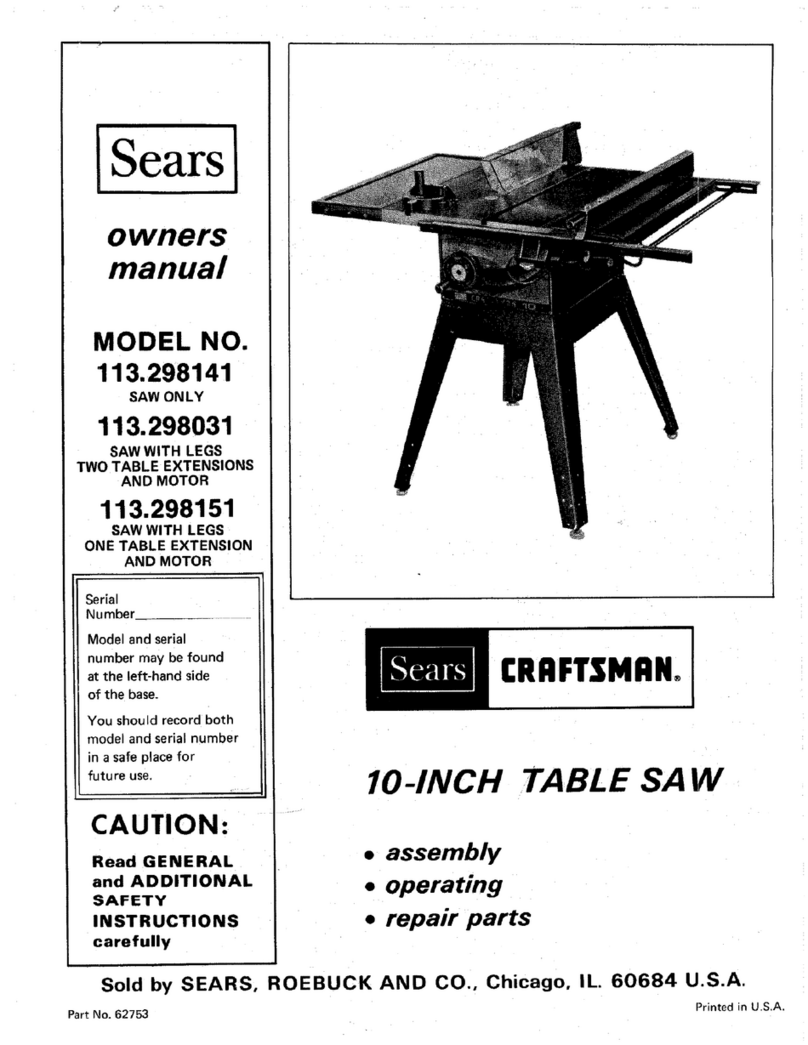
Craftsman
Craftsman 113.298141 owner's manual

Black & Decker
Black & Decker Powerful Solutions KS1400L Original instructions
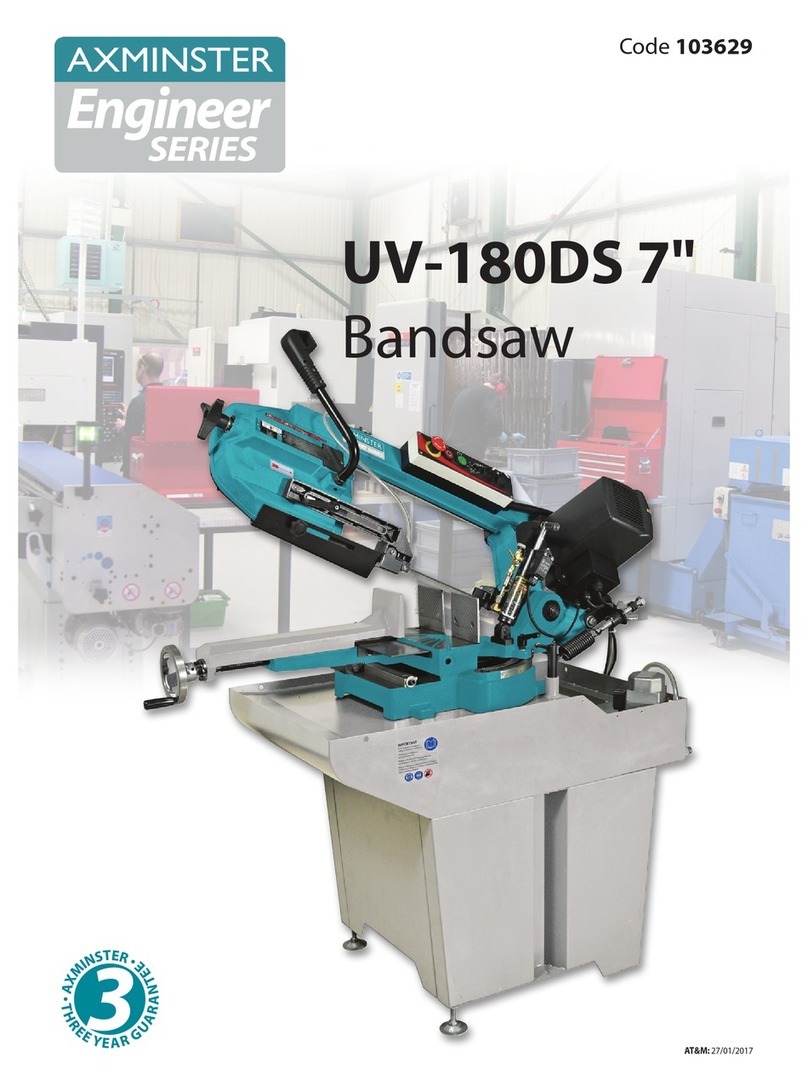
Axminster
Axminster UV-180DS instruction manual
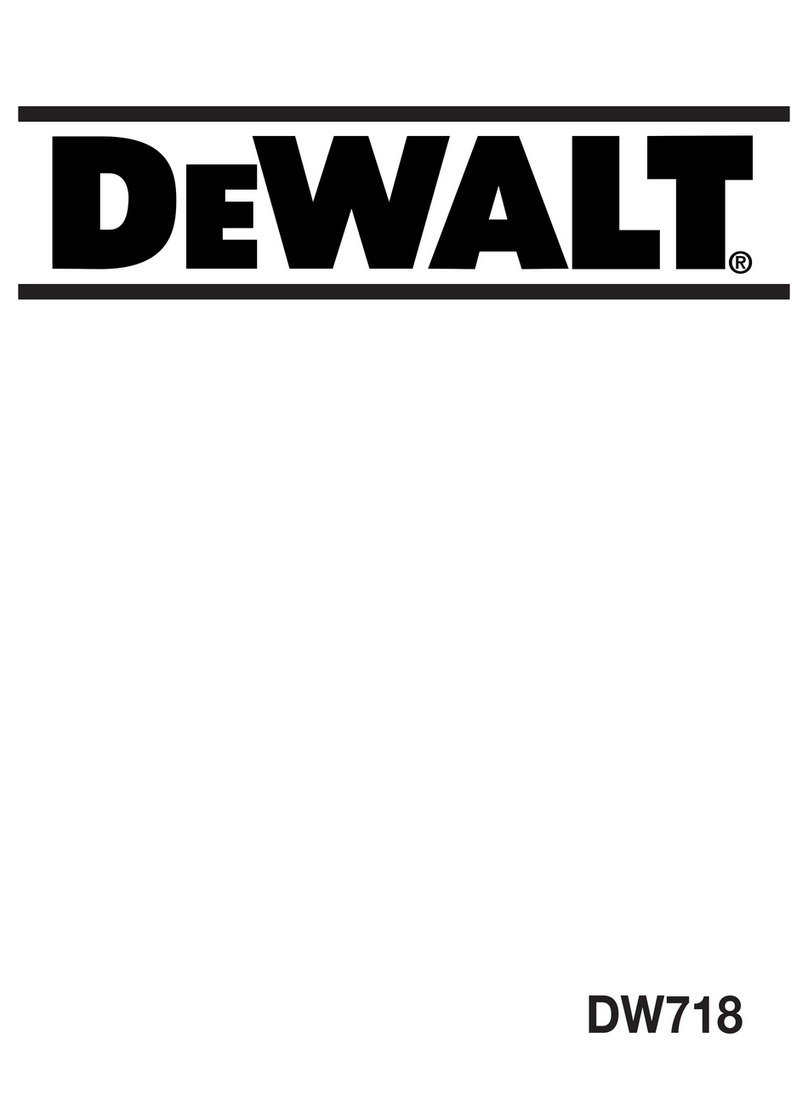
DeWalt
DeWalt DW718 Operator's manual
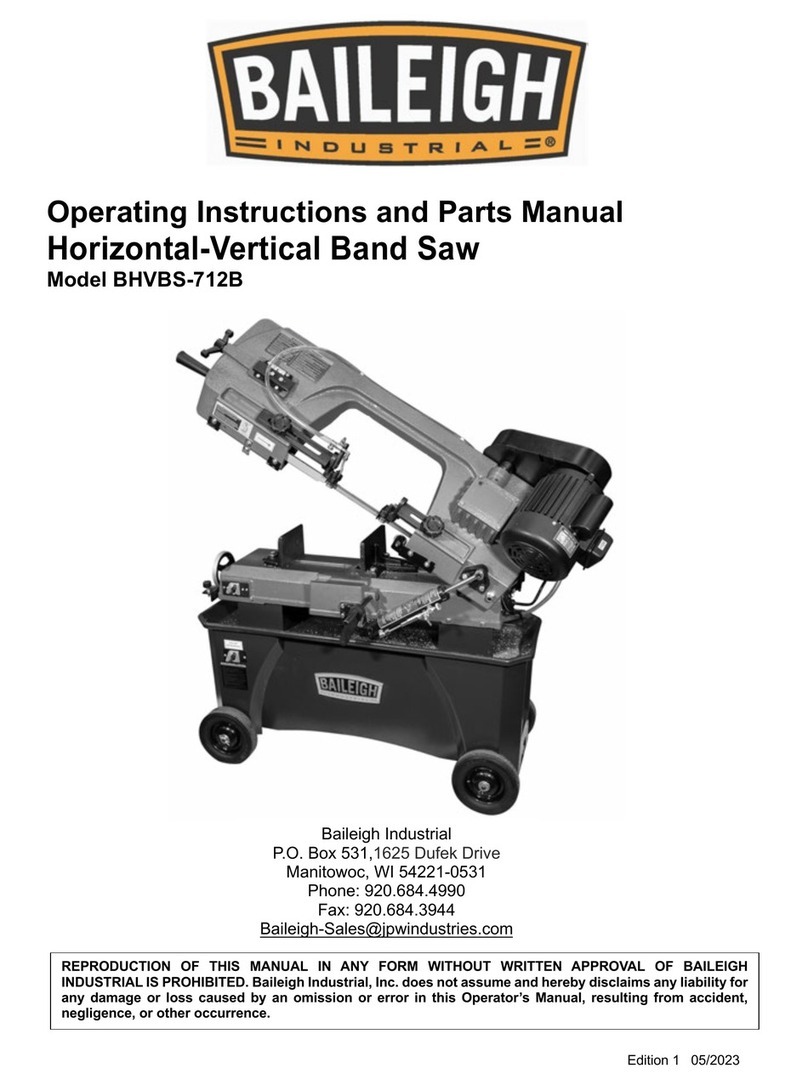
Baileigh Industrial
Baileigh Industrial BHVBS-712B Operating instructions and parts manual

AEG
AEG US 1300 XE Original instructions

SPE
SPE CS230 user guide
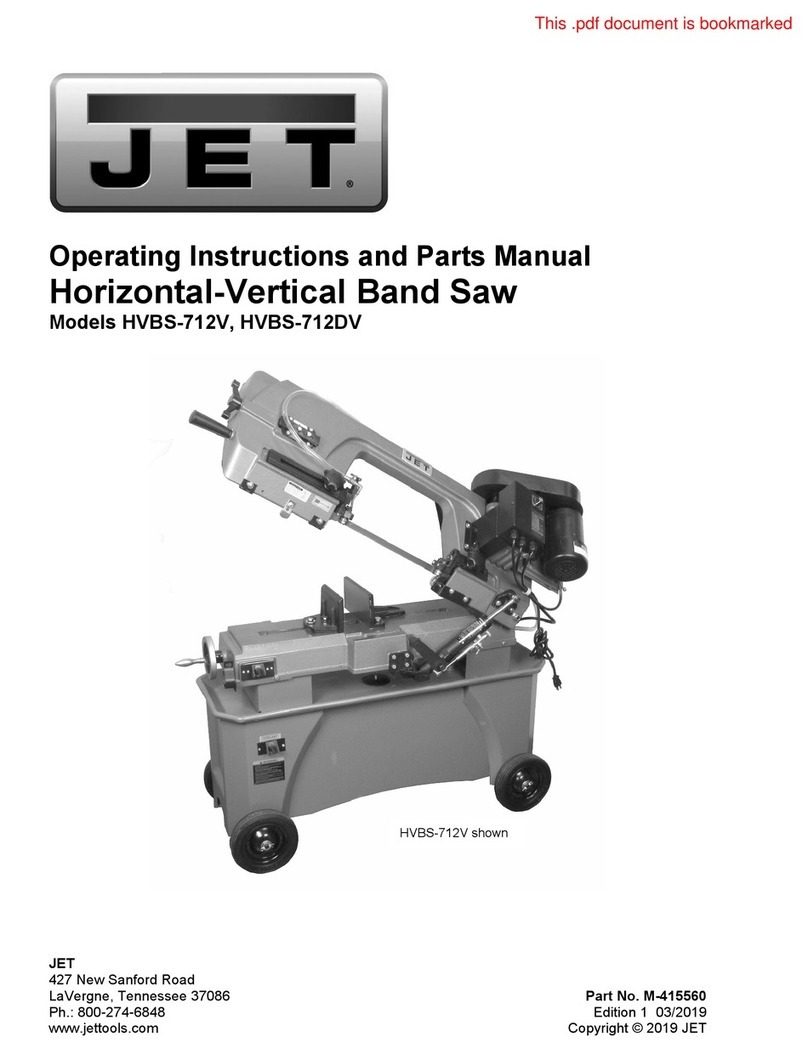
Jet
Jet HVBS-712V Operating instructions and parts manual
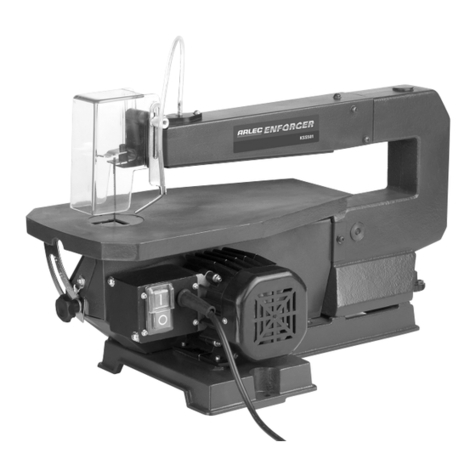
Arlec
Arlec KSS501 instruction manual
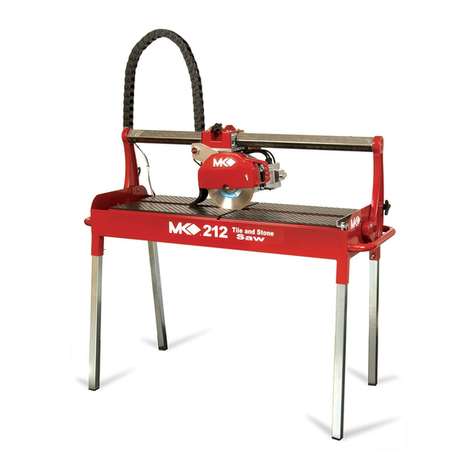
MK Diamond Products
MK Diamond Products MK-212 Series Owner's manual & operating instructions

Dake
Dake Trademaster Instruction manual and parts list
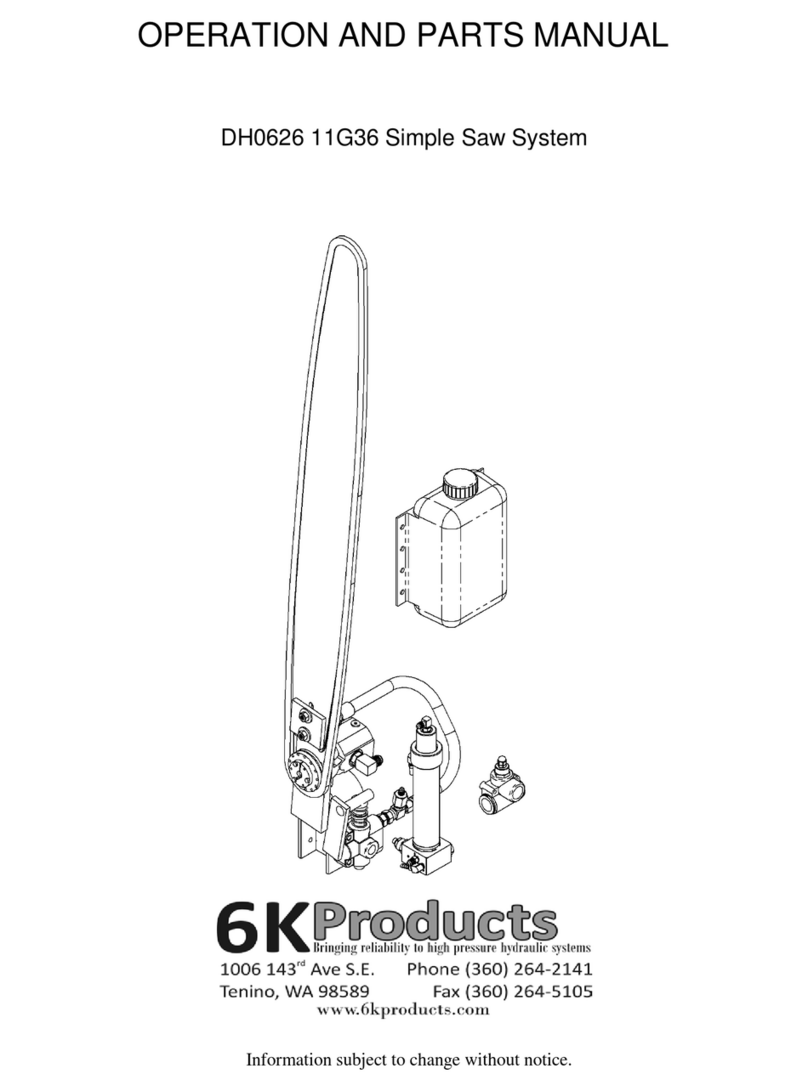
6K Products
6K Products DH0626 Operation and parts manual
